Inbox and Environment News: Issue 499
June 20 - 26, 2021: Issue 499
Consultations On Wakehurst Parkway + Ingleside Development Closing Soon
Proposals For Reducing Flooding On Wakehurst Parkway Now Open For Feedback - Closes Sunday June 27th
Revised South-Ingleside Precinct Housing Development Plan Now Open For Feedback - feedback closes July 6
Mona Vale Dunes Bushcare Group Planting-Out Installs 600 Natives
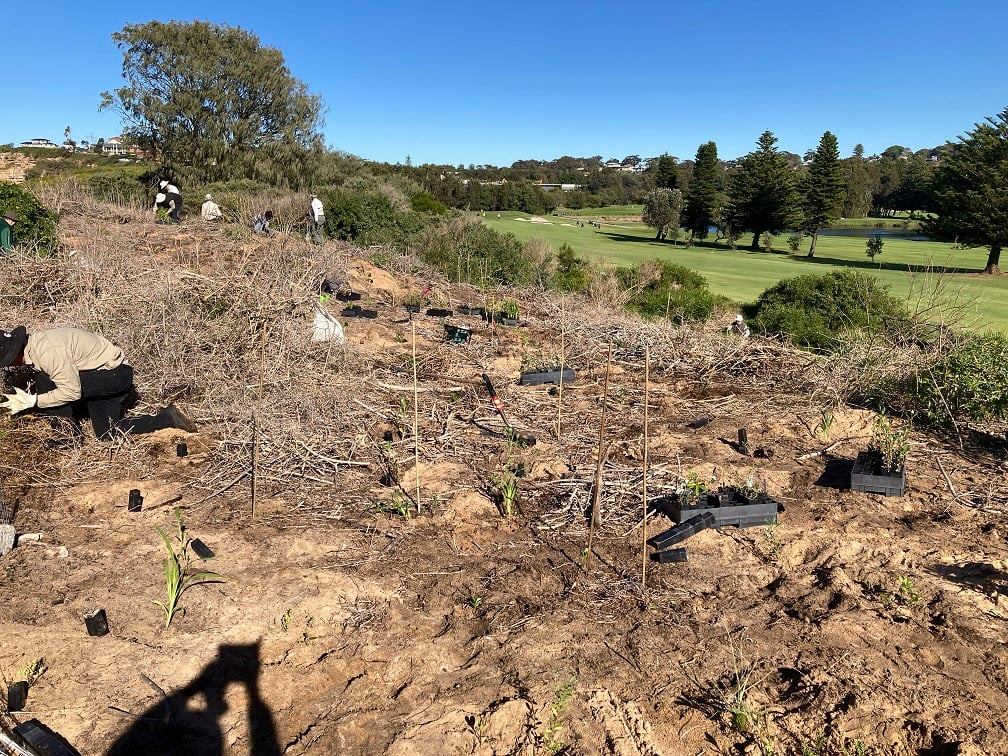
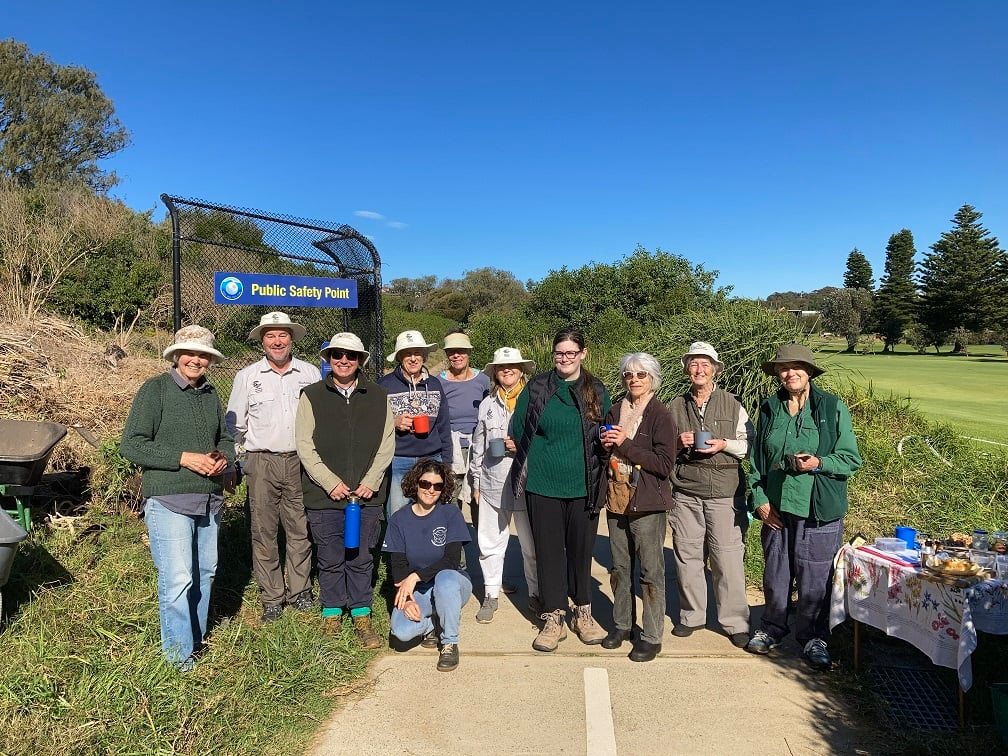
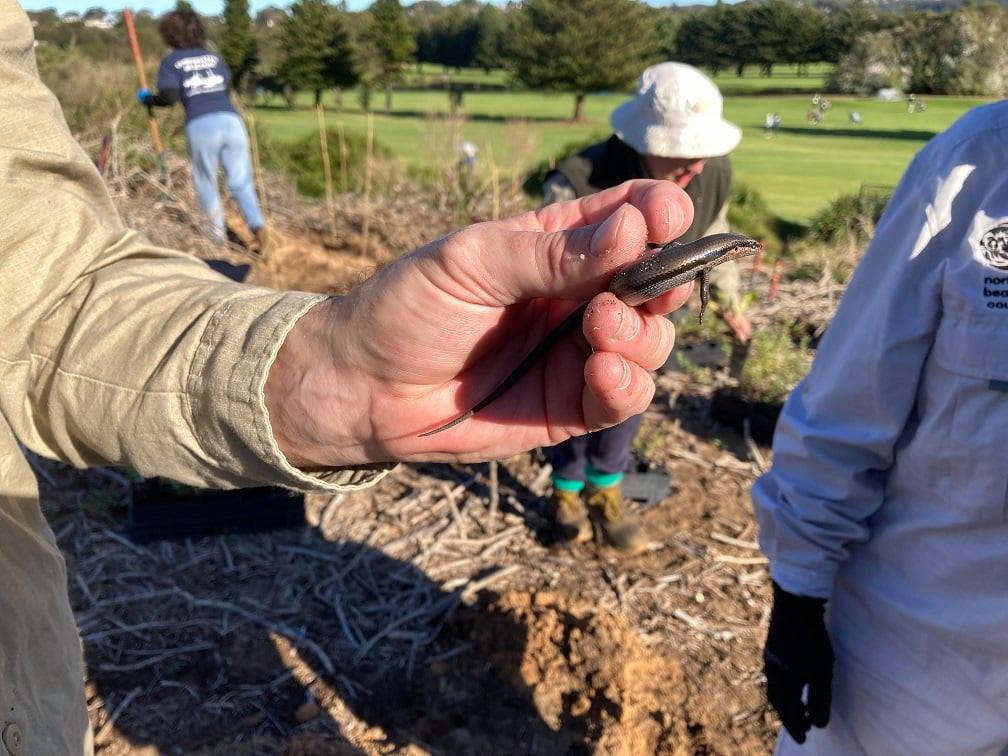
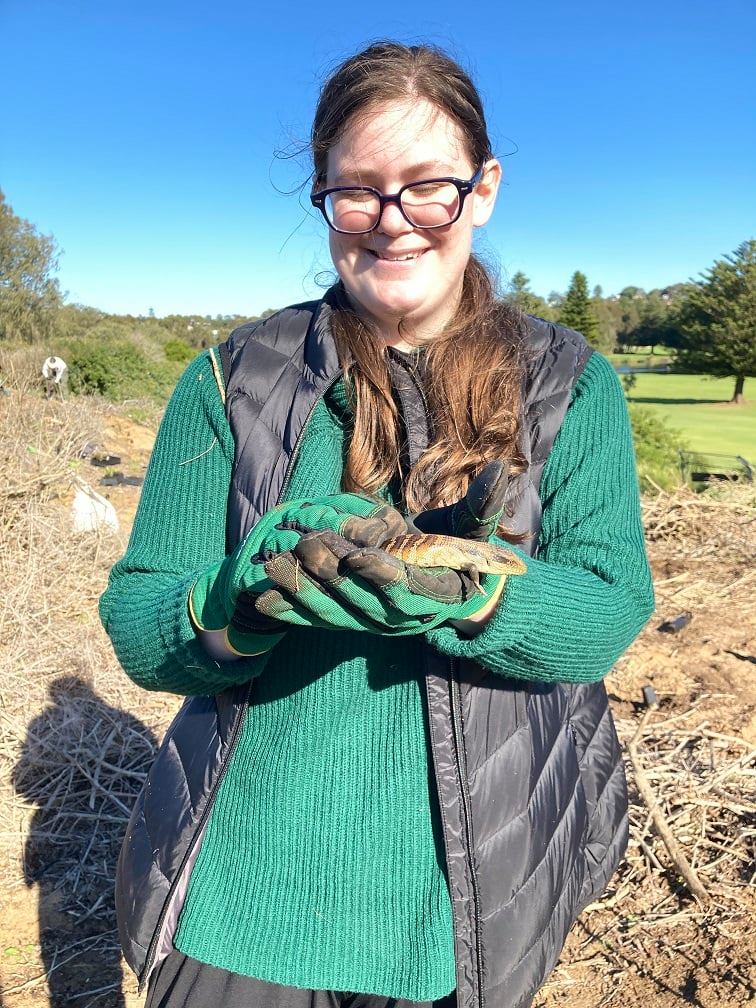
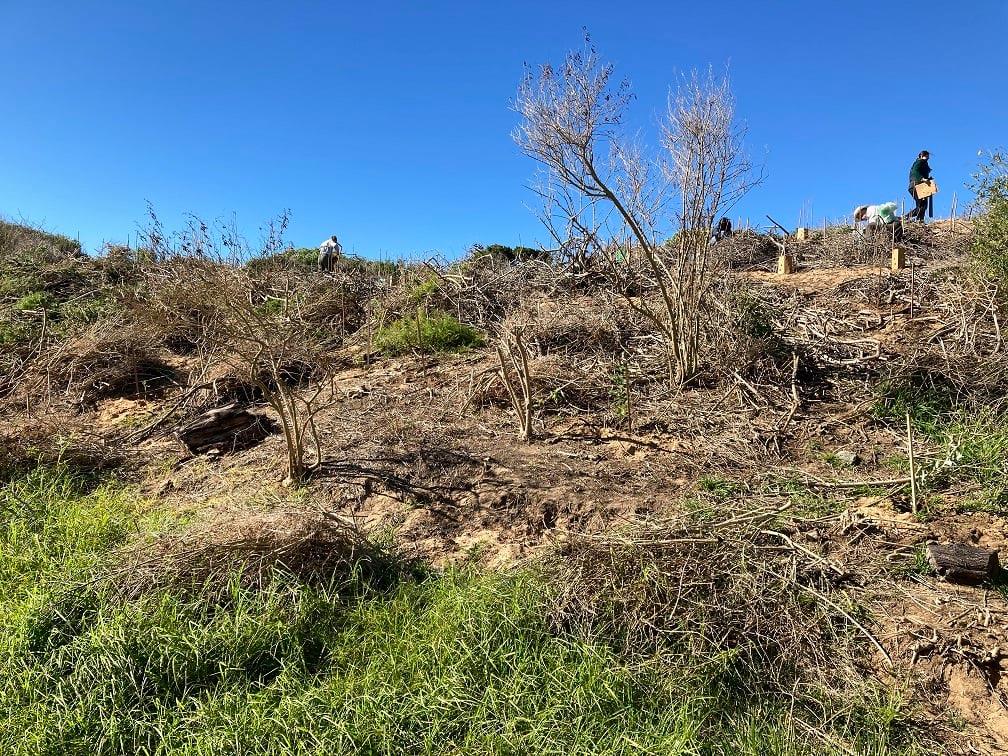
Bangalley Head Landcare Group Progress
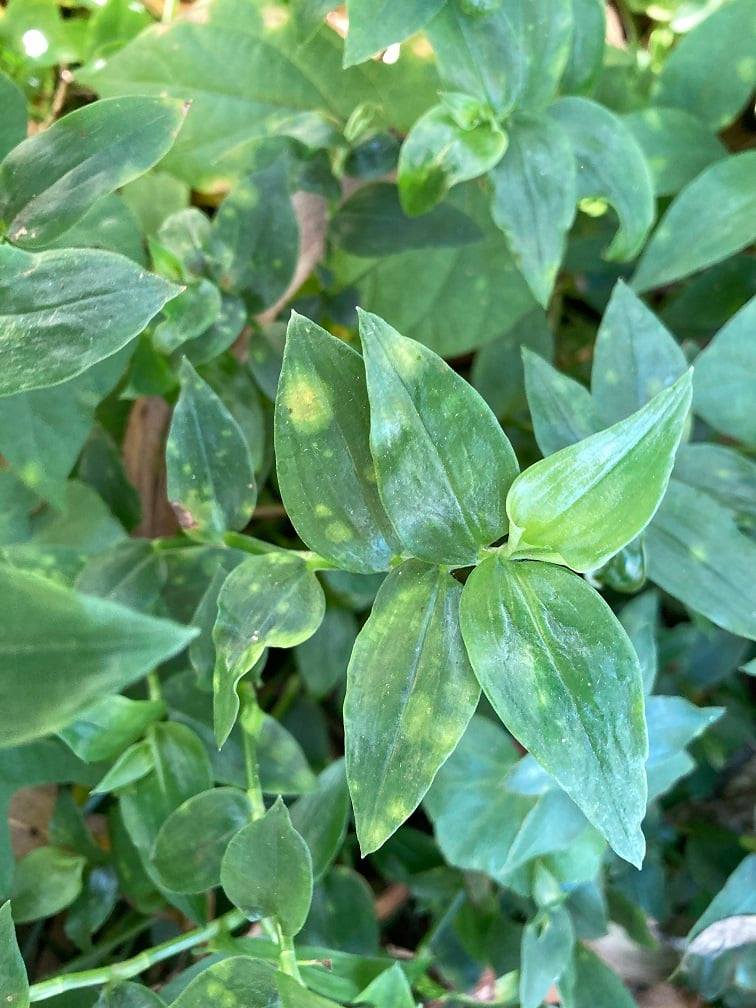
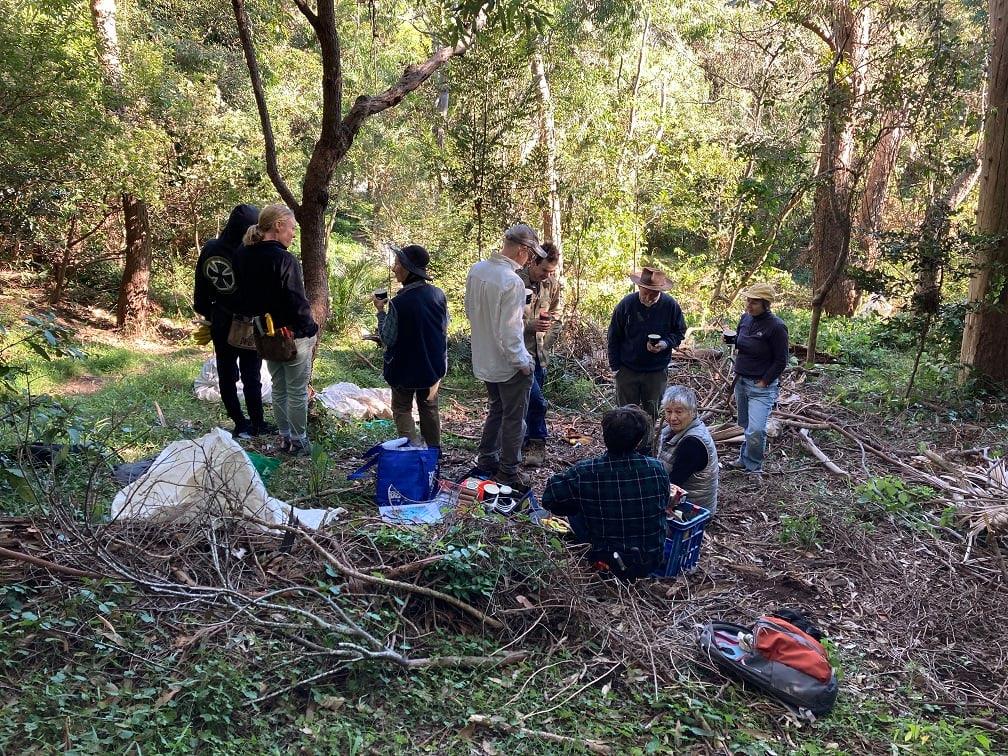
Brookvale To Get Cooler And Greener With Installation Of 250 Trees
Federal Consultation On Endangered Listing For The Koala Now Open - Closes July 30, 2021
Koala Listing Strengthens Call For An Independent Environmental Compliance Agency
Draft National Recovery Plan For The Koala (Combined Populations Of Queensland, New South Wales And The Australian Capital Territory)
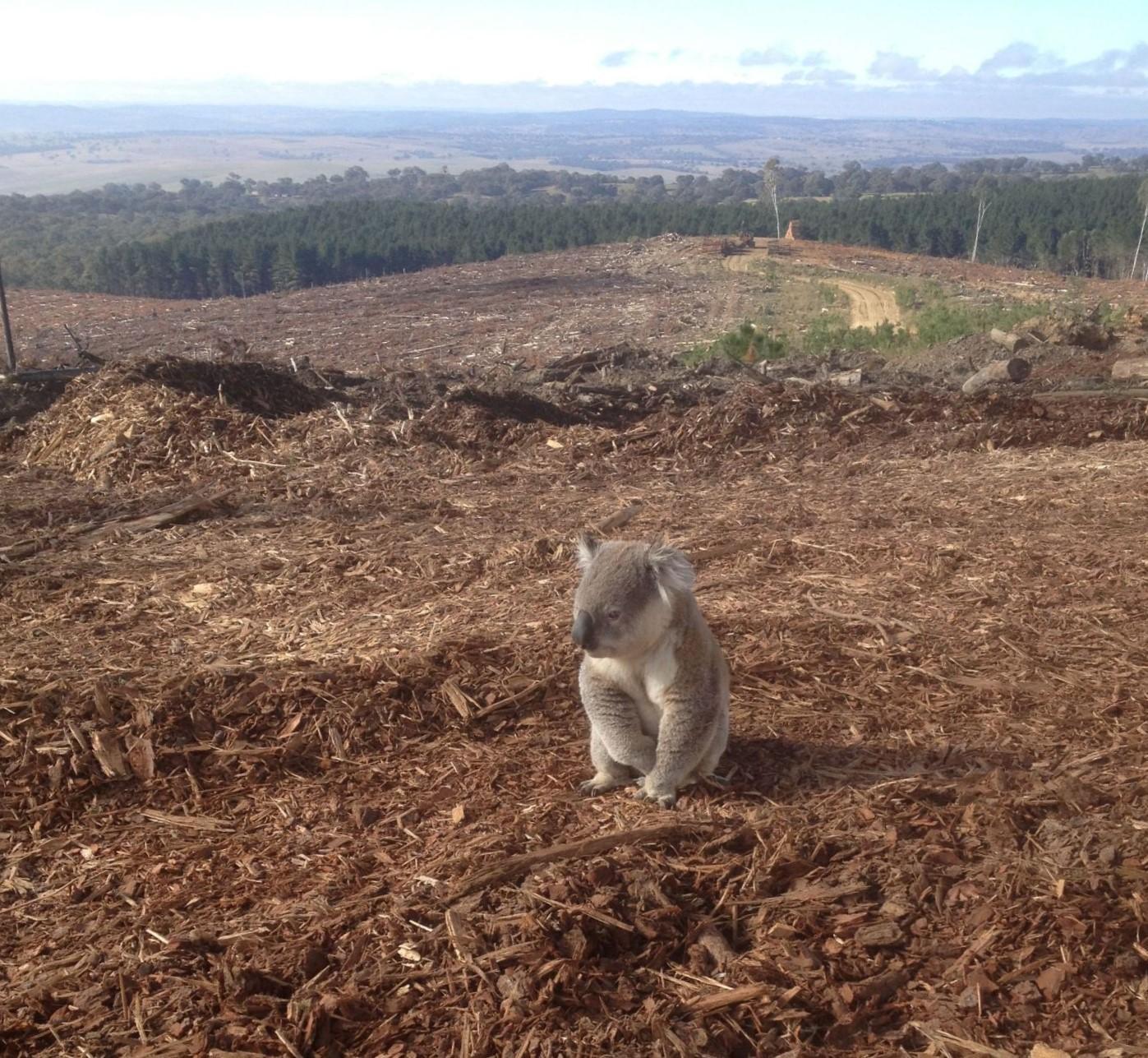
The Powerful Owl Project Update
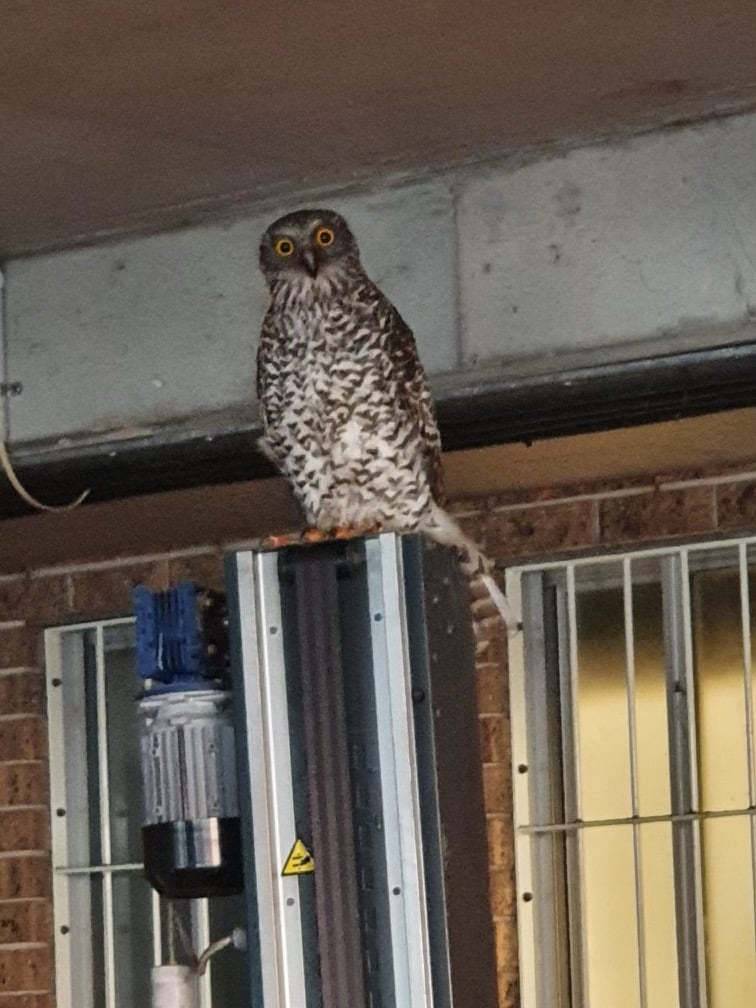
ORRCA News: 2021 Census Day - Sunday June 27
- This is a FREE event for all to join in.
- From sun up to sun down.
- Record all your sightings from your favourite whale watching location using an ORRCA data sheet and sending it into the team at the end of the day.
- Email orrcacensusday@gmail.com for all the details as they unfold.
Heat Spells Doom For Australian Marsupials
Public Concern On Human Health Impact Of Plastic Pollution
NSW Government To Tackle Plastics And Waste
Prioritising The State's Coastline For Future Generations
- Delivering outcomes;
- Reviewing legislation and updating guidance;
- Supporting coordination, collaboration and engagement;
- Providing science and information; and
- Funding and financing.
Piece Of Foreshore History Secured
Fencing Riverbanks Program Cuts Off Access For Wildlife To Water
NSW State Government's Plans To Open Western NSW To Coal Mining Open For Feedback
- Forty-five recorded Aboriginal heritage sites and an additional 13 sites that are restricted and location data not supplied in the proposed coal release areas.
- Twenty-two threatened fauna species and six threatened flora species including the koala, the critically endangered regent honeyeater and the endangered spotted-tailed quoll, as well as four plant species endemic to the Rylstone/western Wollemi area.
- One thousand, eight hundred and fifty-four hectares of groundwater dependant ecosystems.
- Six thousand, six hundred and thirty-four hectares of potential threatened ecological communities.
- Thirty-six water bores.
- One hundred and twenty kilometres of stream channels in good condition and 118 kilometres of stream channels classed as a high level of fragility.
Keith Pitt’s Gas And Oil Basin “Release” Plans For Destruction Of Channel Country
Bin Trim App Helps Waste Industry And Councils Guide Business Recycling
Boris Johnson overstates Morrison’s climate ambition, as Australia-UK trade agreement reached
Michelle Grattan, University of CanberraBritish Prime Minister Boris Johnson put Scott Morrison on the spot when he told their joint news conference he thought the Australian PM had “declared for net zero by 2050”.
When Johnson made the statement a journalist interjected to point out Morrison’s policy was to get to net zero “preferably” by 2050.
Johnson pressed on to say this was “a great step forward when you consider[…] the situation Australia is in. It’s a massive coal producer. It’s having to change the way things are orientated, and everybody understands that.
"You can do it fast. In 2012 this country had 40% of its power from coal. It’s now less than 2%, going down the whole time. […] I’m impressed by the ambition of Australia. Obviously we’re going to be looking for more the whole time, as we go into COP26 in November.”
The net zero moment came as the two stood together to announce they had reached an in-principle agreement on a free trade deal between Britain and Australia – the first such deal the United Kingdom has done post Brexit.
Johnson had been asked whether he wanted Australia to go beyond its present 2030 emissions reduction target.
Morrison has been under strong pressure from both Johnson and United States President Joe Biden to embrace the 2050 target. But he has so far not done so, despite edging towards it. His position is to get to net zero “as soon as possible, preferably by 2050.”
Formally embracing the target would threaten a fight within the Nationals that could destabilise the party’s leader Michael McCormack.
Nationals Senate leader Bridget McKenzie warned this week:
“There is no agreement with the second party of this Coalition government on any target date for zero emissions. In fact it would fly in the face of the Nationals public policy commitment.”
The free trade agreement, which still has details to be finalised, would reduce barriers on the mobility of workers between the two countries as well on trade in goods and services.
The deal would promote more exchange of young people, allowing them to stay and work in each country for three years instead of two. This arrangement would apply to people up to age 35 rather than 30, as at present.
The federal government says Australian producers and farmers would “receive a significant boost by getting greater access to the UK market” while Australian consumers would “benefit from cheaper products, with all tariffs eliminated within five years, and tariffs on cars, whisky, and the UK’s other main exports eliminated immediately” the agreement started.
Australia would within five years place less onerous conditions on British backpackers, who presently have to spend a set time working in agriculture, or other sectors of labour shortage in regional Australia, to get an extension of their visa.
A separate agriculture visa would be established for UK and Australian visa holders, to get more two way traffic (for example, of shearers) in the agricultural sector.
Over 10 to 15 years the UK would liberalise Australian imports of beef and sheep meat, with shorter periods for sugar and dairy products.
The agricultural sectors in both Britain and Australia expressed concerns when the agreement was being negotiated. In Australia farmers have been worried about the possibility of losing labour if the conditions on backpackers were scrapped.
Johnson said the deal would be good for British car manufacturers and the export of British financial and other services, and he hoped for the agricultural sectors on both sides.
On agriculture “we’ve had to negotiate very hard. […] This is a sensitive sector for both sides, and we’ve got a deal that runs over 15 years and contains the strongest possible provisions for animal welfare.”
The removal of the farm work requirement would make it easier for British people and young people to go and work in Australia, he said.
Morrison said the deal would open the pathway to Britain’s entry into the The Comprehensive and Progressive Agreement for Trans-Pacific Partnership (CPTPP).
He also indicated it was “enormously helpful” in the context of the difficulties with China. “Where you have challenges with one trading partner from time to time, then the ability to be able to diversify your trade into more and more countries is incredibly important.”
Morrison and Johnson discussed the final points of the agreement in principle over a dinner meeting at 10 Downing Street. Their talks also included climate change.![]()
Michelle Grattan, Professorial Fellow, University of Canberra
This article is republished from The Conversation under a Creative Commons license. Read the original article.
Australia needs construction waste recycling plants — but locals first need to be won over

Strong community opposition to a proposed waste facility in regional New South Wales made headlines earlier this year. The A$3.9 million facility would occupy 2.7 hectares of Gunnedah’s industrial estate. It’s intended to process up to 250,000 tonnes a year of waste materials from Sydney.
Much of this is construction waste that can be used in road building after processing. Construction of the plant will employ 62 people and its operation will create 30 jobs. Yet every one of the 86 public submissions to the planning review objected to the project.
Residents raised various concerns, which received widespread local media coverage. They were concerned about water management, air quality, noise, the impact of hazardous waste, traffic and transport, fire safety and soil and water. For instance, a submission by a local businessman and veterinary surgeon stated:
“The proposed facility is too close to town, residences and other businesses […] Gunnedah is growing and this proposed development will be uncomfortably close to town in years to come.”
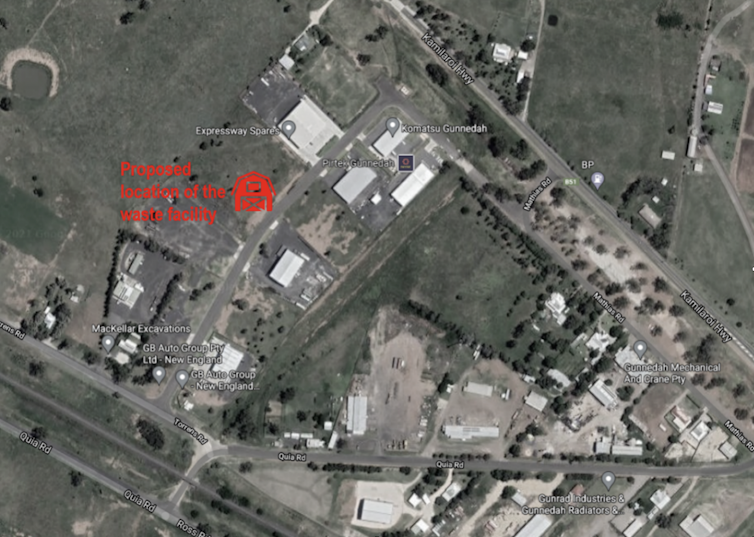
The general manager of the applicant said descriptions such as “toxic waste dump” were far from accurate.
“It’s not a dump […] Its prime focus is to reclaim, reuse and recycle.”
He added: “[At present] the majority of this stuff goes to landfill. What we’re proposing is very beneficial to the environment, which is taking these resources and putting them back into recirculation. The reality is the population is growing, more waste is going to get generated and the upside is we’re much better processing and claiming out of it than sending it to landfill.”
Read more: We create 20m tons of construction industry waste each year. Here's how to stop it going to landfill
Why Are These Facilities Needed?
According to the latest data in the National Waste Report 2020, Australia generated 27 million tonnes of waste (44% of all waste) from the construction and demolition (C&D) sector in 2018-19. That’s a 61% increase since 2006-07. This waste stream is the largest source of managed waste in Australia and 76% of it is recycled.
However, recycling rates and processing capacities still need to increase massively. The environmental impact statement for the Gunnedah project notes Sydney “is already facing pressure” to dispose of its growing construction waste. Most state and national policies – including the NSW Waste Avoidance and Resource Recovery Strategy 2014-2021, NSW Waste and Resource Recovery Infrastructure Strategy and 2018 National Waste Policy – highlight the need to develop infrastructure to effectively manage this waste.
Read more: The 20th century saw a 23-fold increase in natural resources used for building
Why, Then, Do People Oppose These Facilities?
Public opposition to new infrastructure in local neighbourhoods, the Not-in-My-Back-Yard (NIMBY) attitude, is a global phenomenon. Australia is no exception. We have seen previous public protests against waste facilities being established in local areas.
The academic literature reports the root causes of this resistance are stench and other air pollution, and concerns about impacts on property values and health. Factors that influence individuals’ perceptions include education level, past experience of stench and proximity to housing.

What Are The Other Challenges Of Recycling?
Our research team at RMIT University explore ways to effectively manage construction and demolition waste, with a focus on developing a circular economy. Our research shows this goal depends heavily on the development of end markets for recycled products. Operators then have the confidence to invest in recycling construction and demolition waste, knowing it will produce a reasonable return.
Read more: The planned national waste policy won't deliver a truly circular economy
A consistent supply of recycled material is needed too. We believe more recycling infrastructure needs to be developed all around Australia. Regional areas are the most suitable for this purpose because they have the space and a need for local job creation.
To achieve nationwide waste recycling, however, everyone must play their part. By everyone, we mean suppliers, waste producers, waste operators, governments and the community.
Today we are facing new challenges such as massive urbanisation, shortage of virgin materials, increasing greenhouse gas emissions and bans on the export of waste. These challenges warrant new solutions, which include sharing responsibility for the waste we all generate.
Read more: A crisis too big to waste: China's recycling ban calls for a long-term rethink in Australia
What Can Be Done To Resolve Public Concerns?
Government has a key role to play in educating the public about the many benefits of recycling construction and demolition waste. These benefits include environmental protection, more efficient resource use, reduced construction costs, and job creation.
Government must also ensure communities are adequately consulted. A local news report reflected Gunnedah residents’ concern that the recycling facility’s proponent had not contacted them. They initiated the contact. One local said:
“I do understand the short-term financial gains a development like this will bring to the community, but also know the financial and environmental burden they will cause.”
Feedback from residents triggered a series of consultation sessions involving all parties.
A robust framework for consulting the community, engaging stakeholders and providing information should be developed to accompany any such development. Community education programs should be based on research.
For instance, research indicates that, unlike municipal waste recycling facilities, construction and demolition waste management facilities have negligible to manageable impact on the environment and residents’ health and well-being. This is due to the non-combustible nature of most construction materials, such as masonrt.
Such evidence needs to be communicated effectively to change negative community attitudes towards construction and demolition waste recycling facilities. At RMIT, through our National Construction & Demolition Waste Research and Industry Portal, we continue to play our part in increasing public awareness of the benefits.
Read more: With the right tools, we can mine cities ![]()
Salman Shooshtarian, Research Fellow, RMIT University and Tayyab Maqsood, Associate Dean and Head of of Project Management, RMIT University
This article is republished from The Conversation under a Creative Commons license. Read the original article.
An act of God, or just bad management? Why trees fall and how to prevent it
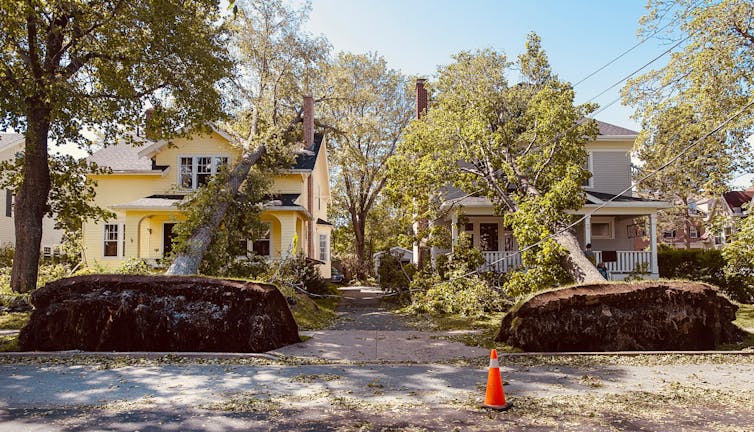
The savage storms that swept Victoria last week sent trees crashing down, destroying homes and blocking roads. Under climate change, stronger winds and extreme storms will be more frequent. This will cause more trees to fall and, sadly, people may die.
These incidents are sometimes described as an act of God or Mother Nature’s fury. Such descriptions obscure the role of good management in minimising the chance a tree will fall. The fact is, much can be done to prevent these events.
Trees must be better managed for several reasons. The first, of course, is to prevent damage to life and property. The second is to avoid unnecessary tree removals. Following storms, councils typically see a spike in requests for tree removals – sometimes for perfectly healthy trees.
A better understanding of the science behind falling trees – followed by informed action – will help keep us safe and ensure trees continue to provide their many benefits.
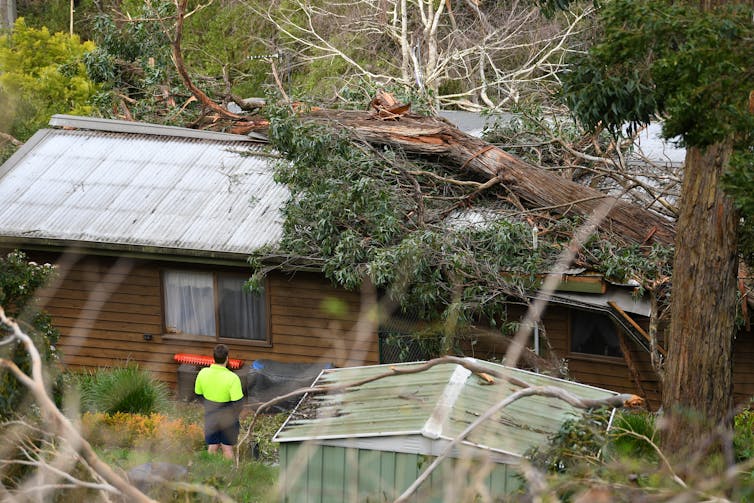
Why Trees Fall Over
First, it’s important to note that fallen trees are the exception at any time, including storms. Most trees won’t topple over or shed major limbs. I estimate fewer than three trees in 100,000 fall during a storm.
Often, fallen trees near homes, suburbs and towns were mistreated or poorly managed in preceding years. In the rare event a tree does fall over, it’s usually due to one or more of these factors:
1. Soggy soil
In strong winds, tree roots are more likely to break free from wet soil than drier soil. In arboriculture, such events are called windthrow.
A root system may become waterlogged when landscaping alters drainage around trees, or when house foundations disrupt underground water movement. This can be overcome by improving soil drainage with pipes or surface contouring that redirects water away from trees.
You can also encourage a tree’s root growth by mulching around the tree under the “dripline” – the outer edge of the canopy from which water drips to the ground. Applying a mixed-particle-size organic mulch to a depth of 75-100 millimetres will help keep the soil friable, aerated and moist. But bear in mind, mulch can be a fire risk in some conditions.
Root systems can also become waterlogged after heavy rain. So when both heavy rain and strong winds are predicted, be alert to the possibility of falling trees.
Read more: Why there's a lot more to love about jacarandas than just their purple flowers

2. Direct root damage
Human-caused damage to root systems is a common cause of tree failure. Such damage can include roots being:
- cut when utility services are installed
- restricted by a new road, footpath or driveway
- compacted over time, such as when they extend under driveways.
Trees can take a long time to respond to disturbances. When a tree falls in a storm, it may be the result of damage inflicted 10-15 years ago.
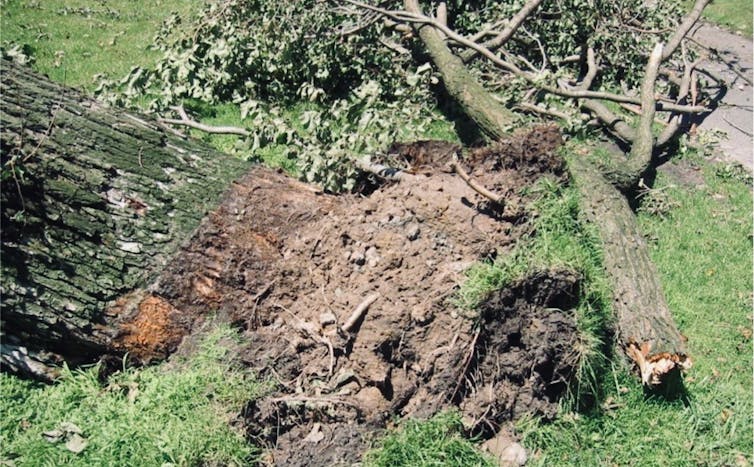
3. Wind direction
Trees anchor themselves against prevailing winds by growing roots in a particular pattern. Most of the supporting root structure of large trees grows on the windward side of the trunk.
If winds come from an uncommon direction, and with a greater-than-usual speed, trees may be vulnerable to falling. Even if the winds come from the usual direction, if the roots on the windward side are damaged, the tree may topple over.
The risk of this happening is likely to worsen under climate change, when winds are more likely to come from new directions.
4. Dead limbs
Dead or dying tree limbs with little foliage are most at risk of falling during storms. The risk can be reduced by removing dead wood in the canopy.
Trees can also fall during strong winds when they have so-called “co-dominant” stems. These V-shaped stems are about the same diameter and emerge from the same place on the trunk.
If you think you might have such trees on your property, it’s well worth having them inspected. Arborists are trained to recognise these trees and assess their danger.
Read more: The years condemn: Australia is forgetting the sacred trees planted to remember our war dead
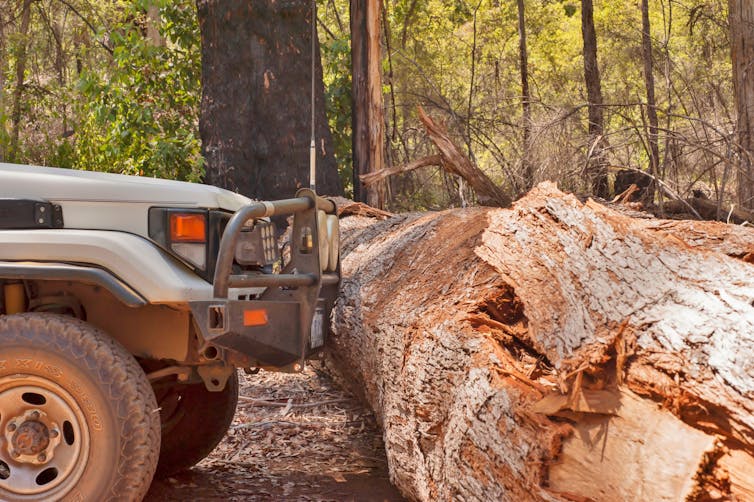
Trees Are Worth The Trouble
Even with the best tree management regime, there is no guarantee every tree will stay upright during a storm. Even a healthy, well managed tree can fall over in extremely high winds.
While falling trees are rare, there are steps we can take to minimise the damage they cause. For example, in densely populated areas, we should consider moving power and communications infrastructure underground.
By now, you may be thinking large trees are just too unsafe to grow in urban areas, and should be removed. But we need trees to help us cope with storms and other extreme weather.
Removing all trees around a building can cause wind speeds to double, which puts roofs, buildings and lives at greater risk. Removing trees from steep slopes can cause the land to become unstable and more prone to landslides. And of course, trees keep us cooler during summer heatwaves.
Victoria’s spate of fallen trees is a concern, but removing them is not the answer. Instead, we must learn how to better manage and live with them.
Read more: Here are 5 practical ways trees can help us survive climate change ![]()
Gregory Moore, Doctor of Botany, The University of Melbourne
This article is republished from The Conversation under a Creative Commons license. Read the original article.
Peatlands worldwide are drying out, threatening to release 860 million tonnes of carbon dioxide every year
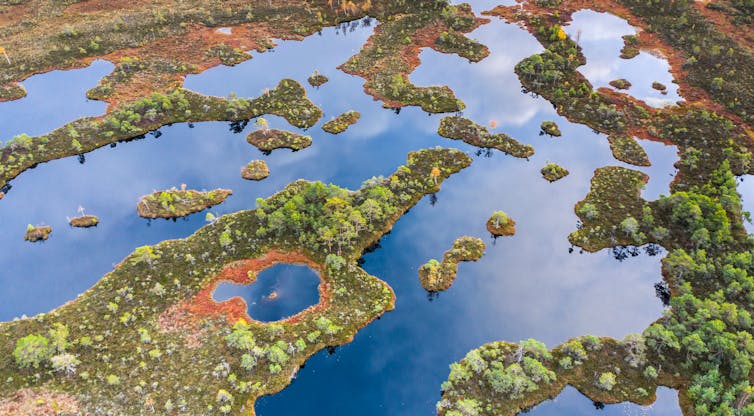
Peatlands, such as fens, bogs, marshes and swamps, cover just 3% of the Earth’s total land surface, yet store over one-third of the planet’s soil carbon. That’s more than the carbon stored in all other vegetation combined, including the world’s forests.
But peatlands worldwide are running short of water, and the amount of greenhouse gases this could set loose would be devastating for our efforts to curb climate change.
Specifically, our new research in Nature Climate Change found drying peatlands could release an additional 860 million tonnes of carbon dioxide into the atmosphere every year, by around 2100. To put this into perspective, Australia emitted 539 million tonnes in 2019.
To stop this from happening, we need to urgently preserve and restore healthy, water-logged conditions in peatlands. These thirsty peatlands need water.
Peatlands Are Like Natural Archives
Peatlands are found across the world: the arctic tundra, coastal marshes, tropical swamp forests, mountainous fens and blanket bogs on subantarctic islands.
They’re characterised by having water-logged soil filled with very slowly decaying plant material (the “peat”) that accumulated over tens of thousands of years, preserved by the low-oxygen environment. This partially decomposed plant debris is locked up in the soils as organic carbon.
Read more: Peat bogs: restoring them could slow climate change – and revive a forgotten world
Peatlands can act like natural archives, letting scientists and archaeologists reconstruct past climate, vegetation, and even human lives. In fact, an estimated 20,500 archaeological sites are preserved under or within peat in the UK.
As unique habitats, peatlands are home for many native and endangered species of plants and animals that occur nowhere else, such as the white-bellied cinclodes (Cinclodes palliatus) in Peru and Australia’s giant dragonfly (Petalura gigantea), the world’s largest. They can also act as migration corridors for birds and other animals, and can purify water, regulate floods, retain sediments and so on.
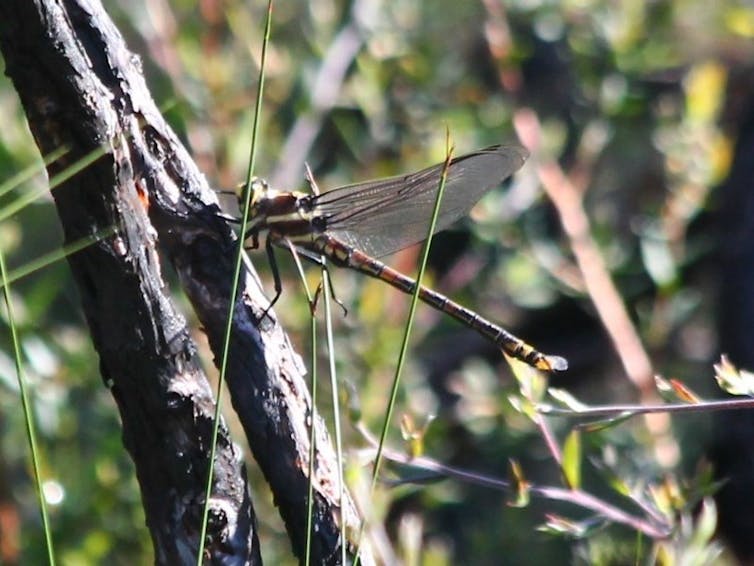
But over the past several decades, humans have been draining global peatlands for a range of uses. This includes planting trees and crops, harvesting peat to burn for heat, and for other land developments.
For example, some peatlands rely on groundwater, such as portions of the Greater Everglades, the largest freshwater marsh in the United States. Over-pumping groundwater for drinking or irrigation has cut off the peatlands’ source of water.
Together with the regional drier climate due to global warming, our peatlands are drying out worldwide.
What Happens When Peatlands Dry Out?
When peat isn’t covered by water, it could be exposed to enough oxygen to fuel aerobic microbes living within. The oxygen allows the microbes to grow extremely fast, enjoy the feast of carbon-rich food, and release carbon dioxide into the atmosphere.
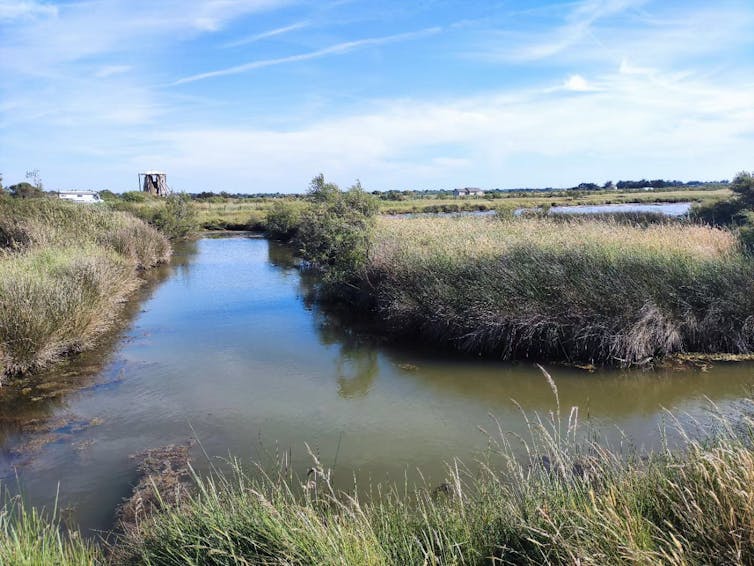
Some peatlands are also a natural source of methane, a potent greenhouse gas with the warming potential up to 100 times stronger than carbon dioxide.
But generating methane actually requires the opposite conditions to generating carbon dioxide. Methane is more frequently released in water-saturated conditions, while carbon dioxide emissions are mostly in unsaturated conditions.
Read more: Emissions of methane – a greenhouse gas far more potent than carbon dioxide – are rising dangerously
This means if our peatlands are getting drier, we would have an increase in emissions of carbon dioxide, but a reduction in methane emissions.
So What’s The Net Impact On Our Climate?
We were part of an international team of scientists across Australia, France, Germany, Netherlands, Switzerland, the US and China. Together, we collected and analysed a large dataset from carefully designed and controlled experiments across 130 peatlands all over the world.
In these experiments, we reduced water under different climate, soil and environmental conditions and, using machine learning algorithms, disentangled the different responses of greenhouse gases.
Our results were striking. Across the peatlands we studied, we found reduced water greatly enhanced the loss of peat as carbon dioxide, with only a mild reduction of methane emissions.
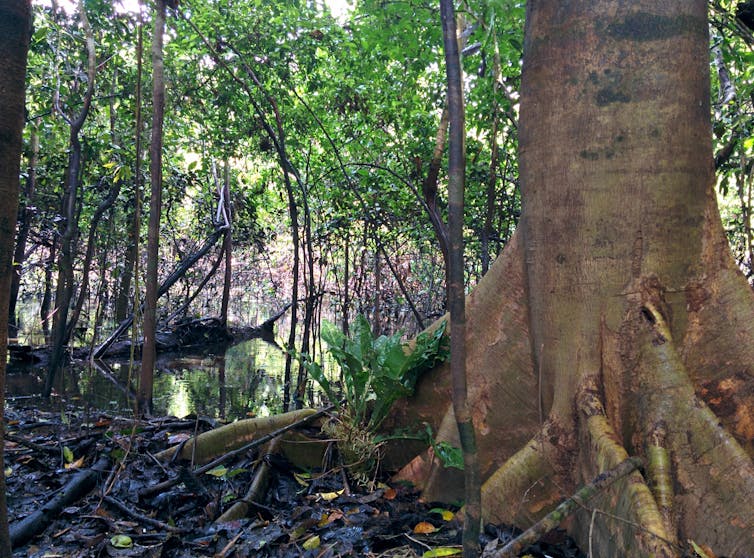
The net effect — carbon dioxide vs methane — would make our climate warmer. This will seriously hamper global efforts to keep temperature rise under 1.5℃.
This suggests if sustainable developments to restore these ecosystems aren’t implemented in future, drying peatlands would add the equivalent of 860 million tonnes of carbon dioxide to the atmosphere every year by 2100. This projection is for a “high emissions scenario”, which assumes global greenhouse gas emissions aren’t cut any further.
Protecting Our Peatlands
It’s not too late to stop this from happening. In fact, many countries are already establishing peatland restoration projects.
For example, the Central Kalimantan Peatlands Project in Indonesia aims to rehabilitate these ecosystems by, for instance, damming drainage canals, revegetating areas with native trees, and improving local socio-economic conditions and introducing more sustainable agricultural techniques.
Likewise, the Life Peat Restore project aims to restore 5,300 hectares of peatlands back to their natural function as carbon sinks across Poland, Germany and the Baltic states, over five years.
But protecting peatlands is a global issue. To effectively take care of our peatlands and our climate, we must work together urgently and efficiently.
Read more: People, palm oil, pulp and planet: four perspectives on Indonesia's fire-stricken peatlands ![]()
Yuanyuan Huang, Research Scientist , CSIRO and Yingping Wang, Chief research scientist, CSIRO
This article is republished from The Conversation under a Creative Commons license. Read the original article.
'Unshackled' Palm-Destroying Beetles Could Soon Invade Australia
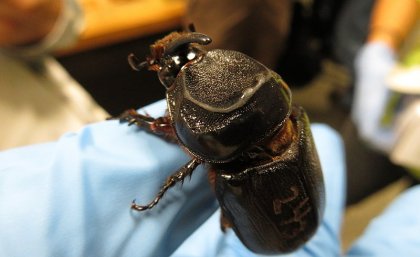 A destructive pest beetle is edging closer to Australia as biological controls fail, destroying home gardens, plantations and biodiversity as they surge through nearby Pacific islands. University of Queensland researcher Dr Kayvan Etebari has been studying how palm-loving coconut rhinoceros beetles have been accelerating their invasion.
A destructive pest beetle is edging closer to Australia as biological controls fail, destroying home gardens, plantations and biodiversity as they surge through nearby Pacific islands. University of Queensland researcher Dr Kayvan Etebari has been studying how palm-loving coconut rhinoceros beetles have been accelerating their invasion.New Plan To Revitalise NSW's Oldest Park By Installing Mountain Bike Trails
- Royal National Park, Heathcote National Park, Garawarra State Conservation Area Draft Planning Considerations
- Royal National Park, Heathcote National Park and Garawarra State Conservation Area Draft Plan of Management
- Royal National Park, Heathcote National Park and Garawarra State Conservation Area Draft Mountain Biking Plan
Bushcare In Pittwater
Where we work Which day What time
Avalon
Angophora Reserve 3rd Sunday 8:30 - 11:30am
Avalon Dunes 1st Sunday 8:30 - 11:30am
Avalon Golf Course 2nd Wednesday 3 - 5:30pm
Careel Creek 4th Saturday 8:30 - 11:30am
Toongari Reserve 3rd Saturday 9 - 12noon (8 - 11am in summer)
Bangalley Headland 2nd Sunday 9 to 12noon
Bayview
Winnererremy Bay 4th Sunday 9 to 12noon
Bilgola
North Bilgola Beach 3rd Monday 9 - 12noon
Algona Reserve 1st Saturday 9 - 12noon
Plateau Park 1st Friday 8:30 - 11:30am
Church Point
Browns Bay Reserve 1st Tuesday 9 - 12noon
McCarrs Creek Reserve Contact Bushcare Officer To be confirmed
Clareville
Old Wharf Reserve 3rd Saturday 8 - 11am
Elanora
Kundibah Reserve 4th Sunday 8:30 - 11:30am
 Mona Vale
Mona Vale Mona Vale Beach Basin 1st Saturday 8 - 11am
Mona Vale Dunes 2nd Saturday +3rd Thursday 8:30 - 11:30am
Newport
Bungan Beach 4th Sunday 9 - 12noon
Crescent Reserve 3rd Sunday 9 - 12noon
North Newport Beach 4th Saturday 8:30 - 11:30am
Porter Reserve 2nd Saturday 8 - 11am
North Narrabeen
Irrawong Reserve 2nd Saturday 2 - 5pm
Palm Beach
North Palm Beach Dunes 3rd Saturday 9 - 12noon
Scotland Island
Catherine Park 2nd Sunday 10 - 12:30pm
Elizabeth Park 1st Saturday 9 - 12noon
Pathilda Reserve 3rd Saturday 9 - 12noon
Warriewood
Warriewood Wetlands 1st Sunday 8:30 - 11:30am
Whale Beach
Norma Park 1st Friday 9 - 12noon
Western Foreshores
Coopers Point, Elvina Bay 2nd Sunday 10 - 1pm
Rocky Point, Elvina Bay 1st Monday 9 - 12noon
Gardens And Environment Groups And Organisations In Pittwater
Avalon Golf Course Bushcare Needs You


Pittwater Reserves

New Shorebirds WingThing For Youngsters Available To Download
A Shorebirds WingThing educational brochure for kids (A5) helps children learn about shorebirds, their life and journey. The 2021 revised brochure version was published in February 2021 and is available now. You can download a file copy here.
If you would like a free print copy of this brochure, please send a self-addressed envelope with A$1.10 postage (or larger if you would like it unfolded) affixed to: BirdLife Australia, Shorebird WingThing Request, 2-05Shorebird WingThing/60 Leicester St, Carlton VIC 3053.

 Shorebird Identification Booklet
Shorebird Identification Booklet
The Migratory Shorebird Program has just released the third edition of its hugely popular Shorebird Identification Booklet. The team has thoroughly revised and updated this pocket-sized companion for all shorebird counters and interested birders, with lots of useful information on our most common shorebirds, key identification features, sighting distribution maps and short articles on some of BirdLife’s shorebird activities.
The booklet can be downloaded here in PDF file format: http://www.birdlife.org.au/documents/Shorebird_ID_Booklet_V3.pdf
Paper copies can be ordered as well, see http://www.birdlife.org.au/projects/shorebirds-2020/counter-resources for details.
Download BirdLife Australia's children’s education kit to help them learn more about our wading birdlife
Shorebirds are a group of wading birds that can be found feeding on swamps, tidal mudflats, estuaries, beaches and open country. For many people, shorebirds are just those brown birds feeding a long way out on the mud but they are actually a remarkably diverse collection of birds including stilts, sandpipers, snipe, curlews, godwits, plovers and oystercatchers. Each species is superbly adapted to suit its preferred habitat. The Red-necked Stint is as small as a sparrow, with relatively short legs and bill that it pecks food from the surface of the mud with, whereas the Eastern Curlew is over two feet long with a exceptionally long legs and a massively curved beak that it thrusts deep down into the mud to pull out crabs, worms and other creatures hidden below the surface.
Some shorebirds are fairly drab in plumage, especially when they are visiting Australia in their non-breeding season, but when they migrate to their Arctic nesting grounds, they develop a vibrant flush of bright colours to attract a mate. We have 37 types of shorebirds that annually migrate to Australia on some of the most lengthy and arduous journeys in the animal kingdom, but there are also 18 shorebirds that call Australia home all year round.
What all our shorebirds have in common—be they large or small, seasoned traveller or homebody, brightly coloured or in muted tones—is that each species needs adequate safe areas where they can successfully feed and breed.
The National Shorebird Monitoring Program is managed and supported by BirdLife Australia.
This project is supported by Glenelg Hopkins Catchment Management Authority and Hunter Local Land Services through funding from the Australian Government’s National Landcare Program. Funding from Helen Macpherson Smith Trust and Port Phillip Bay Fund is acknowledged.
The National Shorebird Monitoring Program is made possible with the help of over 1,600 volunteers working in coastal and inland habitats all over Australia.
The National Shorebird Monitoring program (started as the Shorebirds 2020 project initiated to re-invigorate monitoring around Australia) is raising awareness of how incredible shorebirds are, and actively engaging the community to participate in gathering information needed to conserve shorebirds.
In the short term, the destruction of tidal ecosystems will need to be stopped, and our program is designed to strengthen the case for protecting these important habitats.
In the long term, there will be a need to mitigate against the likely effects of climate change on a species that travels across the entire range of latitudes where impacts are likely.
The identification and protection of critical areas for shorebirds will need to continue in order to guard against the potential threats associated with habitats in close proximity to nearly half the human population.
Here in Australia, the place where these birds grow up and spend most of their lives, continued monitoring is necessary to inform the best management practice to maintain shorebird populations.
BirdLife Australia believe that we can help secure a brighter future for these remarkable birds by educating stakeholders, gathering information on how and why shorebird populations are changing, and working to grow the community of people who care about shorebirds.
To find out more visit: http://www.birdlife.org.au/projects/shorebirds-2020/shorebirds-2020-program
Aussie Bread Tags Collection Points

Seniors To Benefit From Regional Seniors Travel Card
- the Age Pension through Services Australia or the Department of Veterans’ Affairs
- a Disability Support Pension or a Carer Payment from Services Australia
- a Service Pension issued by the Department of Veterans’ Affairs
- a Disability Pension through the Department of Veterans’ Affairs under the Veterans’ Entitlements Act 1986
- a War Widow(er)’s Pension issued by the Department of Veterans’ Affairs.
Launch Of State Of The (Older) Nation 2021
There are problems in aged care, but more competition isn’t the solution

The solution to most problems in most markets is more competition.
Whether it’s the market for hairdressers, for massage therapists or for general practitioners, usually, the more of them there are in any town or suburb, the greater is the range and quality they offer and the lower the price.
It’s part of the thinking behind a range of government legislation designed to increase competition and consumer choice in residential aged care.
Yet in research just published by the Melbourne Institute using the de-identified records of 2,900 nursing homes provided to the aged care royal commission we found no such effect.
No matter how competition was measured, we found no statistically-significant differences in price or quality as indicated by a range of measures including nursing hours worked per resident, assaults per resident, complaints per resident, the use of antipsychotic drugs and avoidable early deaths.
We measured the amount of competition for each nursing home in three ways: by the number of competitors within a 10-kilometre radius, the distance in kilometres to the nearest competitor and a measure of market concentration known as the Herfindahl-Hirschman Index.
Read more: Aged care, death and taxes after the royal commission
We found great variation in competition (much more in cities, much less in regions) along with slight decreases in competition in urban and remote areas (notwithstanding government measures designed to promote it) and minor increases in competition in regional Australia.
But we found no evidence linking competition to measures of quality of care, with the possible exception of registered nurse hours, although this linkage wasn’t present in all measures of competition.
Competition was weakly associated with price if at all.
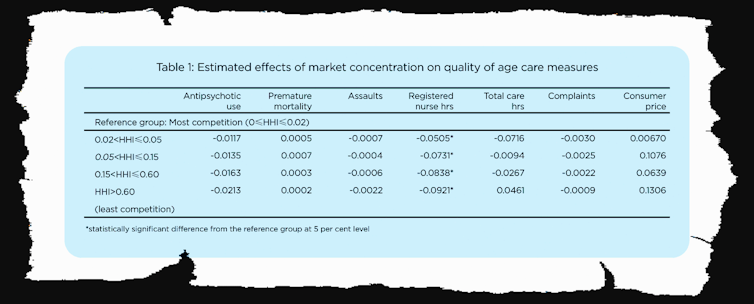
On the other hand, we found strong links between ownership and quality of care.
For most measures of quality, government-owned facilities provided much higher quality of care than for-profit providers and not-for-profit providers.
On prices, government-owned facilities charged by far the lowest price per resident per day — 23% lower than for-profits and 8% lower than not-for-profits.
In trying to think of the reasons why competition should not result in competition on prices or on the quality of service, a number of possibilities present themselves.
Residents Know Little About What They Are Getting
One reason is that demand for aged care places often arises suddenly due to significant changes in health conditions such as falls, dementia and loss of balance meaning they have little choice but to use the first facility that becomes available.
Another is that consumers have little information about quality with which to make decisions. Unlike the United States and the United Kingdom, Australian authorities do not yet provide a five-star system of ratings that can be easily understood.
Read more: 4 key takeaways from the aged care royal commission's final report
And prices are extremely hard to understand.
Demand often arises from consumers who experience sudden changes in their cognitive and physical conditions that make it difficult to search for information, and weigh options and exercise choice.
With users hamstrung, there are few market forces to discipline providers.
We Could Empower Users…
Measures that would help include publishing quality ratings (recommended by the royal commission), simplifying prices (not recommended, although the commission recommends an independent pricing authority) and providing consumer advocates to help people navigate through the system (recommended).
Given that most consumers transition from home care to residential care, it would help if advocacy services were integrated into home care services.
An alternative would be to abandon the pursuit of competition and set up a system of enforced standards, funded for different categories of care along the lines of the casemix system used in hospitals.
…Or Regulate More Strongly On Their Behalf
Although this was recommended in the commission’s final report it would be harder to implement than it is in hospitals.
Aged care is about making life comfortable whereas health care is about fixing problems, making consumer preferences much more important in aged care.
Harnessing the power of consumer preferences is a worthy goal, and there is a great deal we can do to move toward it, but there’s a long way to go.![]()
Ou Yang, Research Fellow, The University of Melbourne; Anthony Scott, Professor, The University of Melbourne; Jongsay Yong, Associate Professor of Economics, The University of Melbourne, and Yuting Zhang, Professor of Health Economics, The University of Melbourne
This article is republished from The Conversation under a Creative Commons license. Read the original article.
New Treatment Stops Progression Of Alzheimer's Disease In Monkey Brains
In neglecting the National Archives, the Morrison government turns its back on the future

Why didn’t the federal government increase funding for the National Archives of Australia in its recent budget?
We know it wasn’t because of budget discipline. Money was splashed around on all sorts of worthy causes. And the emergency funding to save film and magnetic tape recordings from disintegration was modest: A$67 million over seven years.
Nor was it because a scorn for history is in the Liberal Party’s DNA. The party’s founder, Robert Menzies, was a history buff. His library, which is the centrepiece of the newly established Robert Menzies Institute at the University of Melbourne, is full of books of history and biography.
Moreover, his government established the precursor of today’s institution, the Commonwealth Archives Office, in 1961 so the records of the past could help guide the future. Prominent Liberals like Paul Hasluck and David Kemp have written histories, as has John Howard in The Menzies Era.
There are plenty of distinguished Liberal-aligned historians, and historians across the political spectrum supported the open letter to the prime minister, spearheaded by journalist Gideon Haigh and academic Graeme Davison.
Read more: Our history up in flames? Why the crisis at the National Archives must be urgently addressed
Some commentators have seen the failure to provide the archives with emergency funds as a skirmish in the culture wars against an intellectual and cultural left purported to be obsessed with identity politics. This, the argument goes, is of a piece with the government’s apparent hostility to universities, its increase in fees for humanities degrees and its parsimonious treatment of the arts.
But was it that deliberate? Perhaps it was just careless philistinism in a budget designed for a forthcoming election. It was a budget addressed primarily to groups of voters rather than to national problems, and the users of archives will never swing a marginal electorate. Last week, The Australian ran an editorial on the issue, which concluded: “Failure to fund the NAA properly is an oversight that must be corrected.”
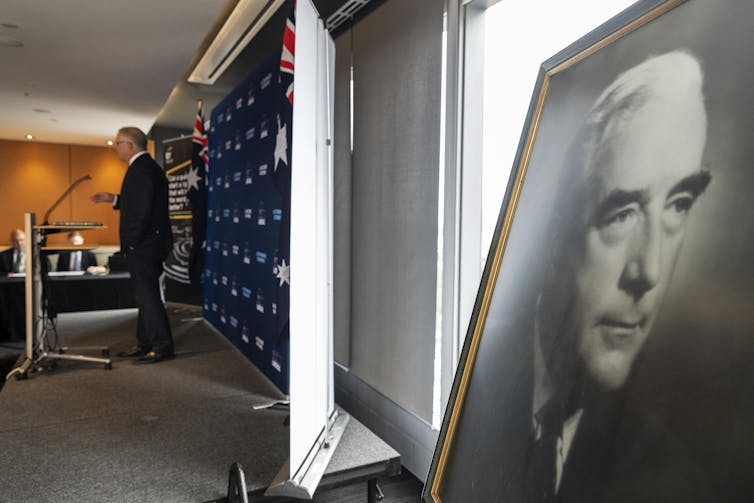
The government is wrong to think it is only professional and academic historians who use the archives. So do family historians, as the archives include personal records of hundreds of thousands of Australians. They are especially relevant to those of non-Anglo descent who had to apply to government authorities for various exemptions and entry permits. These include Indigenous Australians, Chinese living in Australia or displaced persons wanting to immigrate.
Haigh has pointed out that Treasurer Josh Frydenberg’s defence last year of his eligibility to sit in parliament depended on a document in the archives – the certificate of exemption from the provisions of the Immigration Act for his mother, then a seven-year-old girl deemed to be “stateless”.
The National Archives sit in the attorney-general’s department. Queensland Senator Amanda Stoker, who is assistant minister to the attorney-general as well as assistant minister for women and industrial relations, defended the government’s failure to provide the recommended emergency funding with the facile claim that “time marches on and all sources degrade over time”.
The government had nothing to be embarrassed about, she said, even when she was reminded Prince Charles had expressed his alarm at the threatened loss of records. Judging from her silly remarks, she seems to have given the subject little thought. The aim of the letter is to bring the archive’s budgetary neglect to the attention of the prime minister and his senior ministers.
Read more: Jenny Hocking: why my battle for access to the 'Palace letters' should matter to all Australians
While I do not think the neglect of the archives is a deliberate move in the culture wars, it is evidence of the Coalition’s truncated temporal imagination. This is in part an occupational hazard of politicians with their eyes on the electoral cycle. But it is also evident in the difficulty too many of the Coalition have in understanding what climate scientists have been telling them about the future, so they focus on present costs as if future costs will never arrive.
To understand the value of archives, we have to think not just about the past but about the future, when the present will be well and truly over. As the open letter says, the National Archives’ “most important users have not yet been born”, and we do not know what questions they will want to ask.
Thinking about time is difficult, wrenching oneself out of the dramas and routines of the present to fully imagine worlds that were and will be different, confronting our transience and our mortality.
Historians are experts in temporal imagining. They spend their days reading the words and examining the objects of the men and women who walked the world before us. We hope the prime minister will heed our words on the future’s desire for a memory bank of Australian life as full and rich as it can be.![]()
Judith Brett, Emeritus Professor of Politics, La Trobe University
This article is republished from The Conversation under a Creative Commons license. Read the original article.
Is it worth selling my house if I’m going into aged care?

For senior Australians who cannot live independently at home, residential aged care can provide accommodation, personal care and general health care.
People usually think this is expensive. And many assume they need to sell their home to pay for a lump-sum deposit.
But that’s not necessarily the case. Here’s what you need to consider.
Read more: So you're thinking of going into a nursing home? Here's what you'll have to pay for
You May Get Some Financial Support
Fees for residential aged care are complex and can be confusing. Some are for your daily care, some are means-tested, some are for your accommodation and some pay for extras, such as cable TV.
But it’s easier to think of these fees as falling into two categories:
an “entry deposit”, which is usually more than $A300,000, and is refunded when you leave aged care
daily “ongoing fees”, which are $52.71-$300 a day, or more. These cover the basic daily fee, which everyone pays, and the means-tested care fee.
To find out how much government support you’ll receive for both these categories, you will have a “means test” to assess your income and assets. This means test is similar (but different) to the means test for the aged pension.
Generally speaking, the lower your aged-care means test amount, the more government support you’ll receive for aged care.
With full support, you don’t need to pay an “entry deposit”. But you still need to pay the basic daily fee (currently, $52.71 a day), equivalent to 85% of your aged pension. If you get partial support, you pay less for your “entry deposit” and ongoing fees.
Read more: How to check if your mum or dad's nursing home is up to scratch
You Don’t Need A Lump Sum
You don’t have to pay for your “entry deposit” as a lump sum. You can choose to pay a rental-style daily cost instead.
This is calculated as follows: you multiply the amount of the required “entry deposit” by the maximum permissible interest rate. This rate is set by government and is currently at 4.01% per year for new residents. Then you divide that sum by 365 to give a daily rate. This option is like borrowing money to pay for your “entry deposit” via an interest-only loan.
You can also pay for your “entry deposit” with a combination of a lump sum and a daily rental cost.
As it’s not compulsory to pay a lump sum for your “entry deposit”, you have different options for dealing with your family home.
Option 1: Keep Your House And Rent It Out
This allows you to use the rental-style daily cost to finance your “entry deposit”.
Pros
you could have more income from rent. This can help pay for the rental-style daily cost and “ongoing fees” of aged care
you might have a special sentimental attachment to your family house. So keeping it might be a less confronting option
keeping an expensive family house will not heavily impact your residential aged care cost. That’s because any value of your family house above $173,075.20 will be excluded from your means test
you can still access the capital gains of your house, as house prices rise.

Cons
your rental income needs to be included in the means test for your aged pension. So you might get less aged pension
you might need to pay income tax on the rental income
compared to the lump sum payment, choosing the rental-style daily cost means you will end up paying more
you are subject to a changing rental market.
Read more: Home-owning older Australians should pay more for residential aged care
Option 2: Keep Your House And Rent It Out, With A Twist
If you have some savings, you can use a combination of a lump sum and daily rental cost to pay for your “entry deposit”.
Pros
like option 1, you can keep your house and have a steady income
the amount of lump sum deposit will not be counted as an asset in the pension means test.
Cons
like option 1, you could have less pension income, higher age-care costs and need to pay more income tax
you have less liquid assets (assets you could quickly sell or access), which could be handy in an emergency.
Option 3: Sell Your House
If you sell your house, you can use all or part of the proceeds to pay for your “entry deposit”.
Pros
if you have any money left over after selling your house and paying for your “entry deposit”, you can invest the rest
as your “entry deposit” is exempt from your aged pension means test, it means more pension income.
Cons
- if you have money left over after selling your house, this will be included in the aged-care means test. So you can end up with less financial support for aged care.
Read more: What adds value to your house? How to decide between renovating and selling
In A Nutshell
Keeping your house and renting it out (option 1 or 2) can give you a better income stream, which you can use to cover other living costs. And if you’re not concerned about having access to liquid assets in an emergency, option 2 can be better for you than option 1.
But selling your house (option 3) avoids you being exposed to a changing rental market, particularly if the economy is going into recession. It also gives you more capital, and you don’t need to pay a rental-style daily cost.
This article is general in nature, and should not be considered financial advice. For advice tailored to your individual situation and your personal finances, please see a qualified financial planner.
Correction: this article previously stated the amount of lump sum deposit will not be counted as an asset in the aged-care means test, as a pro of option 2. In fact, the amount of lump sum deposit will not be counted as an asset in the pension means test.![]()
Colin Zhang, Lecturer, Department of Actuarial Studies and Business Analytics, Macquarie University
This article is republished from The Conversation under a Creative Commons license. Read the original article.
Our own Nomadland: the Australians caught in a COVID blind spot
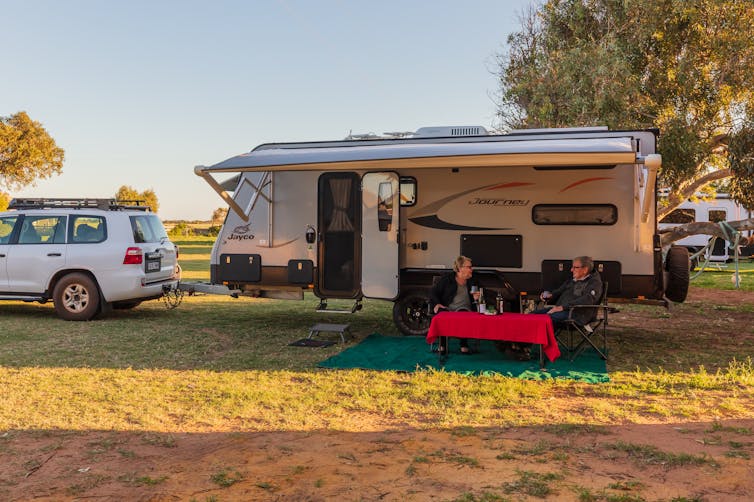
Australians have been told to stay home during lockdowns to prevent the spread of COVID-19. While evidence of the efficacy of this approach as a public health strategy during a pandemic is compelling, lockdowns and mobility restrictions are inevitably disruptive for many – virtually everyone. However, a group that has largely been overlooked is Australia’s nomadic population. Periods of lockdown are particularly challenging for these people, who live in vans, RVs, caravans and boats.
The impacts of restrictions on small businesses, travellers, people in low-paid and insecure jobs who cannot work from home, school children and homeless people have all been widely reported. But with little known about Australia’s nomads, this group has been largely left to their own devices to find secure accommodation and navigate through mobility and border restrictions.
Read more: Australia's mishmash of COVID border closures is confusing, inconsistent and counterproductive
While nomads do not have a conventional single residential address, or live in a brick and mortar home, they are not homeless. Their van, RV, caravan or boat enables them to be permanently mobile while living in their permanent home.
The viability of their nomadic lifestyle depends on being able to freely move from place to place. Free movement enables nomads to access work and social networks as well as minimise living costs.
With the focus now on vaccinating Australians and working out longer-term strategies for managing COVID-19, more attention must be given to this permanently mobile population.
Who Are Nomads?
The recently released US film Nomadland follows the travels of a middle-aged woman who lives permanently in van. The film has raised awareness about the growing nomadic population in the US, and the complex economic and social drivers of this growth.
In modern societies, nomads are best thought of as a diverse group of people who are consciously seeking an alternative housing solution that enables them to balance their social and economic resources, needs and aspirations. Their lives and lifestyles are closely connected to life on the road. For those still in the workforce, a nomadic lifestyle can enable them to find seasonal work year-round.
In Australia, the term nomad has been most often associated with “grey nomads”, a broad group of people who are typically retired or semi-retired. They travel seasonally to warmer areas for winter and to cooler areas for summer.
Read more: Grey nomad lifestyle provides a model for living remotely
How Many Nomads Live In Australia?
Our new research has revealed the exact size and characteristics of the Australian nomad population are unknown and challenging to determine. Estimates vary dramatically from between 2,500 to 40,000, depending on how the group is defined.
Our official population statistics struggle to “capture” the realities of a whole range of population subsets that do not have one permanent place of “usual residence”, which compounds the challenge. The Australian Census, for example, has only three categories for residents: being “at home”, “away from home”, or homeless on census night.
Without knowing the size of the nomad population, it is difficult to determine if the population is growing or by how much. However, recent reports from the UK and US suggest that, largely in response to financial pressures, those countries’ nomadic populations have grown.
As Australia’s property market tightens and housing affordability worsens, it is plausible that more people may opt to sell up their brick and mortar assets (or rent these out for an income) to live a more affordable nomadic lifestyle.
Read more: Soaring housing costs are pushing retirees into areas where disaster risks are high
Searching For A Place To Stay
The closure of national and state parks and informal camping grounds has caused problems for permanent grey nomads. While they are not homeless – their van, RV, caravan or boat is their home – the closure of parks and camping grounds forces them to find alternative safe locations.
For those who are working, travel is often planned to align with seasonal work needs in particular areas. Mobility restrictions and border closures are particularly problematic for those who rely on seasonal work.
An underpinning assumption of Australia’s public health measures to restrict the spread of COVID is that homes are generally not mobile and that people can remain within a location – albeit with disruption. Better information about the size, routes and characteristics of Australia’s nomad population may improve capacity to support them during periods of restrictions.
The Rise Of The Digital Nomad
While COVID-19 restrictions have thrown up many challenges, it appears opportunities are also emerging. Globally, many workplaces are moving work online and the digital nomad population has grown.
Digital nomads are people who work online to maintain a nomadic lifestyle.
So, while there is an urgent need to better ensure Australia’s nomads receive the supports and services they need during COVID-19 lockdowns and more broadly, it’s also worth keeping an eye on the growth of the digital nomad population. We need to consider what might be necessary to support this growing population into the future.![]()
Amanda Davies, Professor of Human Geography, The University of Western Australia and Sarah Prout Quicke, Senior Lecturer, School of Social Sciences, The University of Western Australia
This article is republished from The Conversation under a Creative Commons license. Read the original article.
NSW Government’s Cost Of Living Service
Kanlaya Turns Three!
On Monday 14 June, Asian Elephant calf Kanlaya at Taronga Western Plains Zoo celebrated her third birthday with a special enrichment feed.
Kanlaya has really blossomed over the past three years. In the beginning she was quite shy but now she is an engaged learner who is keen to interact with her keepers and is a very social and playful calf.
Kanlaya is always busy and enjoys playing with four-year-old Sabai. They can be found out in the paddock running around together, fishing for apples in the pool or rolling in the mud.
“We often see Kanlaya alongside her aunty Thong Dee having a swim in the pool when it is raining which is also very special,” said Elephant Keeper Jackie Cantrell.
Over the past 12 months Kanlaya has become more and more independent and playful. Guests to the Zoo would regularly see her on the other side of the paddock to her mum or aunty and she’ll be climbing or rubbing on logs, chasing birds or following Pathi Harn or Sabai around.
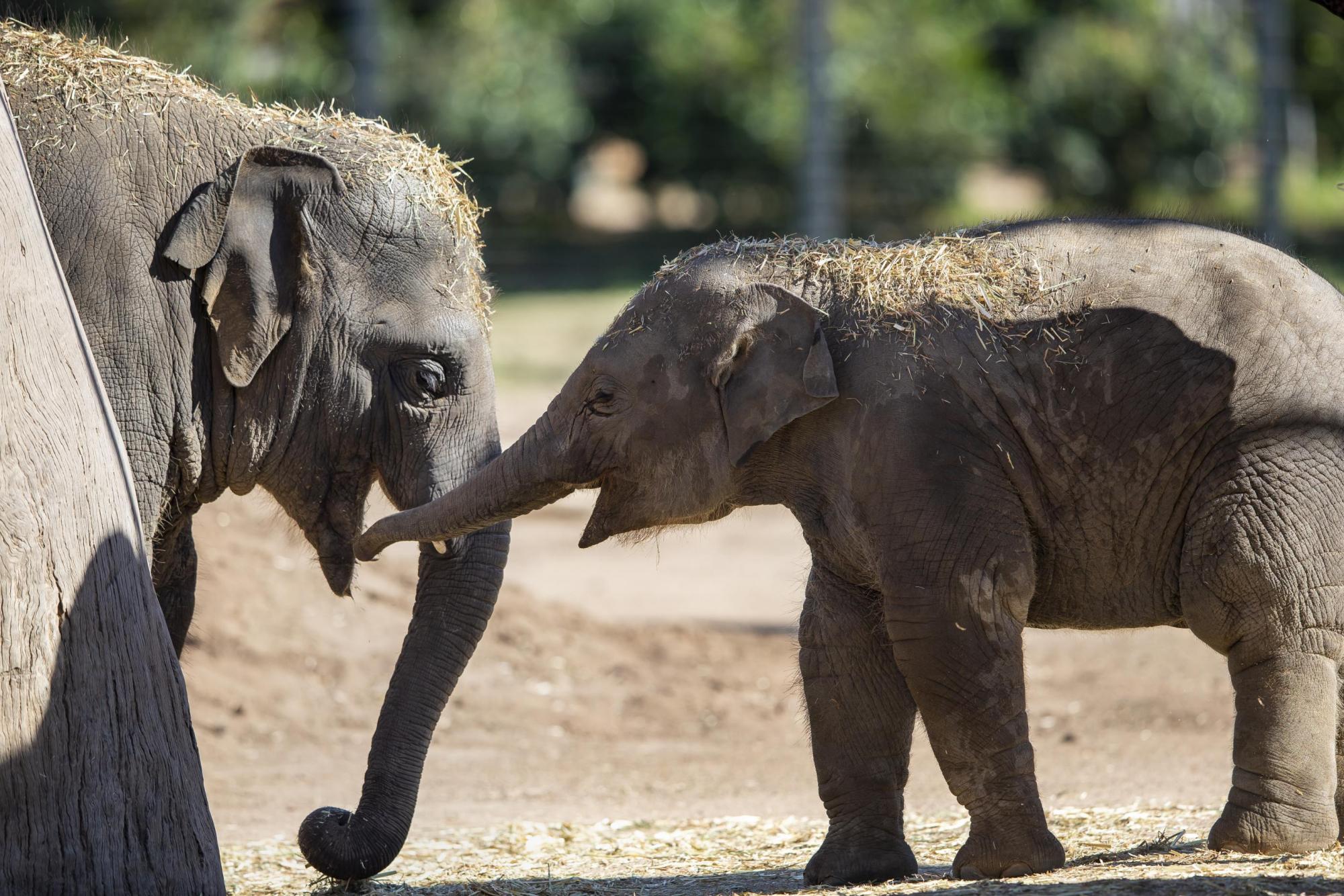
Kanlaya and four-year-old Sabai. Photo by Rick Stevens, Taronga Zoo media
There is so much development that happens for an elephant calf in the first few years of life. Some of these major milestones that Kanlaya has developed include learning to use her truck proficiently, being interested in the food mum is eating and beginning to consume solid food herself, slowly reducing milk intake from mum and learning how to behave around other elephants.
“One interesting aspect about Kanlaya’s growth and development is her weight gain. In the three years she has gained approximately 1100kgs, compared to Gung our adult bull elephant who has only put on 400kgs in the past three years,” said Jackie.
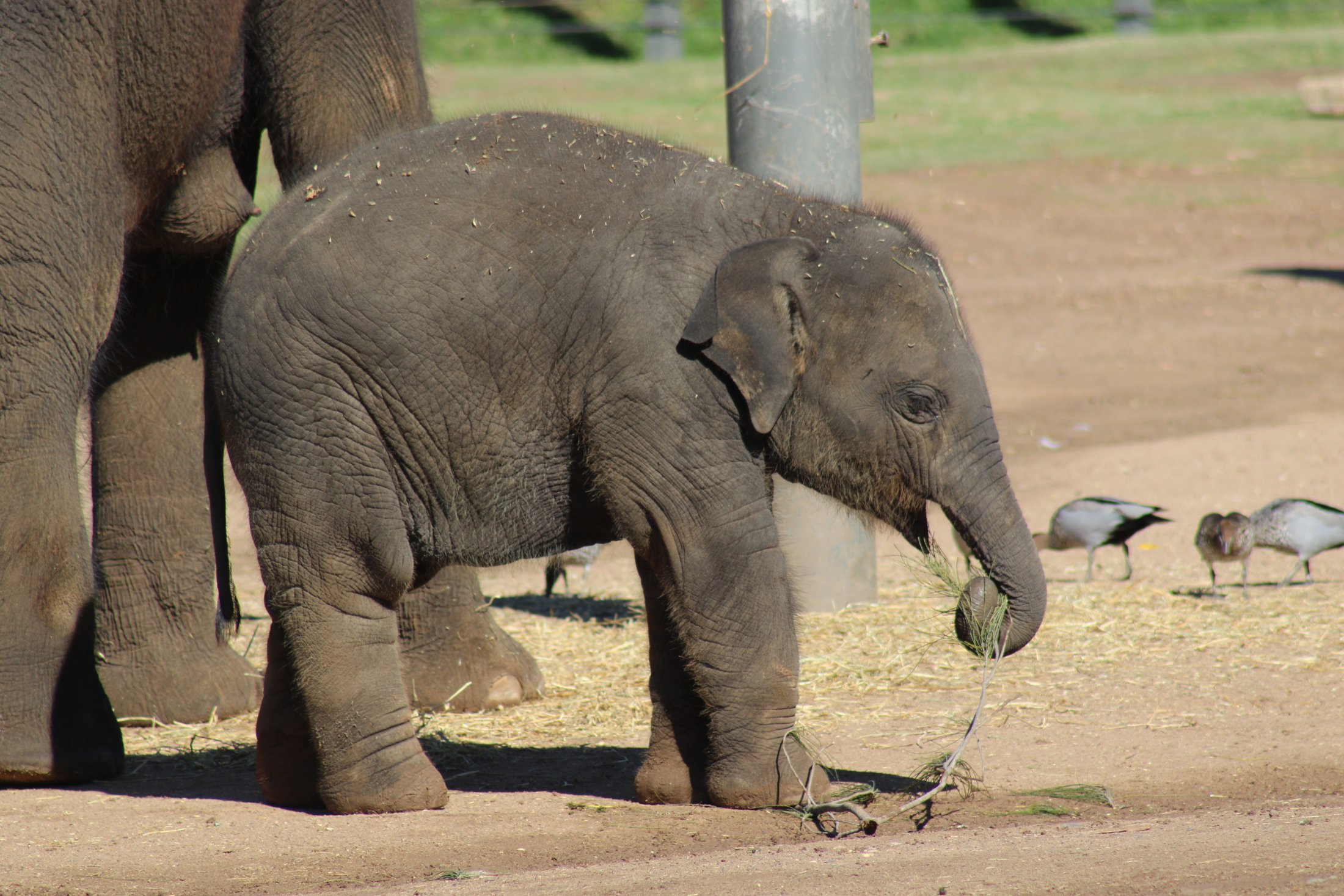
Kanlaya at one year of age. Photo: Taronga Zoo
Seeing Kanlaya be born and watching her grow over the past three years has been a very rewarding experience for many of the keepers.
“Being present to witness the birth of an elephant calf is pretty amazing and an opportunity very few people get to be a part of but it is even more special to be able to foster a relationship with Kanlaya and see her grow and develop.”
“Hopefully I will be present to see her eventually come full circle from calf to a mother of her own calf one day in the future, this would be an incredibly momentous occasion in my life as well as hers,” said Jackie.
Kanlaya was the second calf born here in Dubbo and our first female calf. A lot of planning and preparation goes in to any birth and Kanlaya’s was no exception.
Back track to September 2016, we were training Porntip for Artificial Insemination (AI) and taking regular blood samples from her to track her progesterone levels. By measuring her progesterone levels, we can actually determine the exact day that she will ovulate and time the AI for that day. This requires a lot of planning and preparation, particularly because Kanlaya’s dad does not live in Dubbo, he lives at Perth Zoo in Western Australia. So we organised all the logistics and then a team of specialist elephant reproductive vets flew to Perth to be ready. We took blood on the morning of the 7 September 2016 and the results confirmed ovulation. The team in Perth collected the semen sample straight away and then flew to Dubbo, via Sydney and arrived early that evening. We did the artificial insemination at 8.30pm and the vets were fairly confident because the semen sample was great, 90% motility, and they could see on ultrasound that Porntip had just ovulated. We did a second artificial insemination procedure the following morning to be sure.
We then had to wait approximately three months (the length of an elephant cycle) before we could confirm that Porntip was pregnant and it was at this point we found out it was a success! And then we started the long 22 months wait until our little calf would arrive.
Kanlaya was born on the 14th of June 2018 at 3.07am after a short and easy labour. Her name means ‘beautiful lady’. She is a very confident, playful and energetic calf. Kanlaya spends her the day with the herd and often leads the way out on to exhibit. She loves receiving attention and her training is coming along nicely.
Her Mum is Porntip and is 28 years old. She has a laid back and easy going personality and is very maternal. Porntip is a great mother and aunty to the other calves in the herd.
Kanlaya’s dad Putra Mas lives at Perth Zoo with two other female elephants. Kanlaya is the first calf he has sired. Putra Mas is exceptionally smart and seeks out attention from keepers to do activities, vocalizing to call them over. Keepers at Perth Zoo say he is a perfectionist and learns new behaviours quickly. Putra Mas is a big burley boy, is destructive and loves to play with his toys. If he can break it, he will.
As Kanlaya grows and develops it is nice to see her personality coming out and the different traits she gets from her parents. It is a real pleasure to watch her grow and develop.
By Elephant keeper, Bec O’Riordan and Taronga Zoo
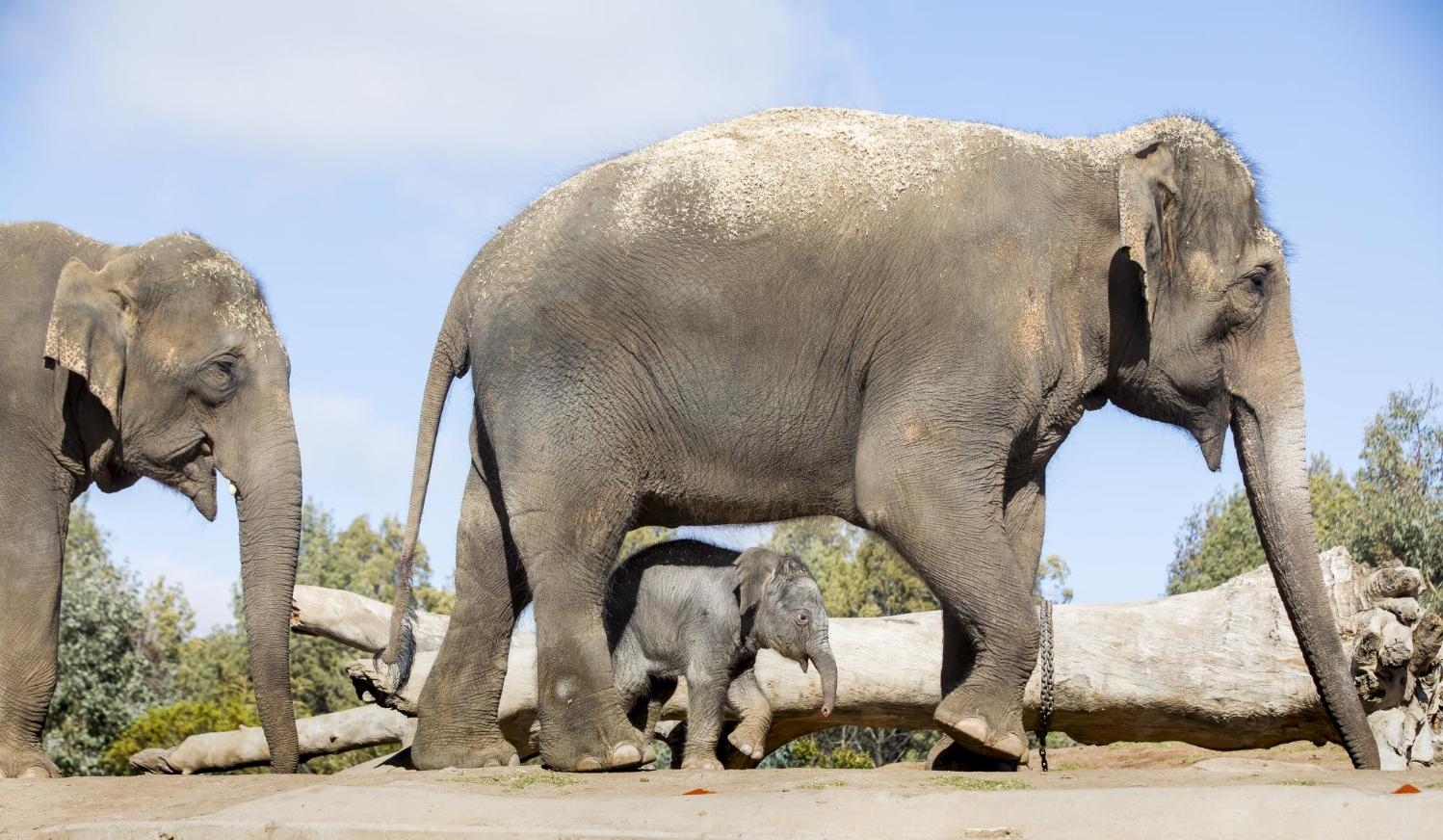
Solid Plastering: Artisans Of Australia
Do You Want To Be A Radio Broadcaster?
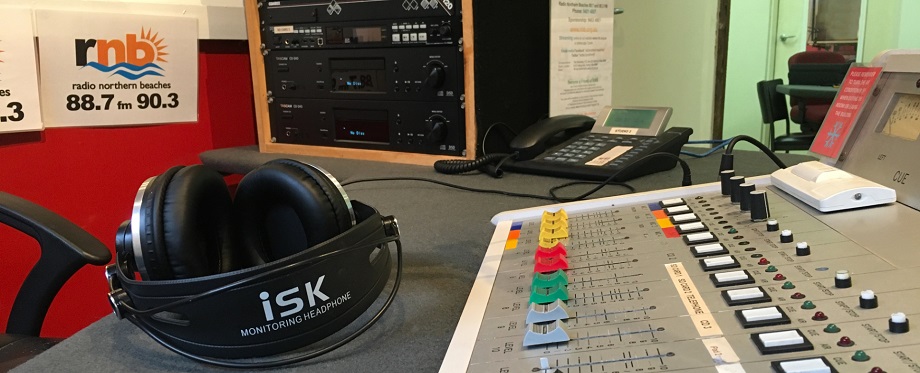
Book review: Farmers or Hunter-gatherers? The Dark Emu Debate rigorously critiques Bruce Pascoe’s argument
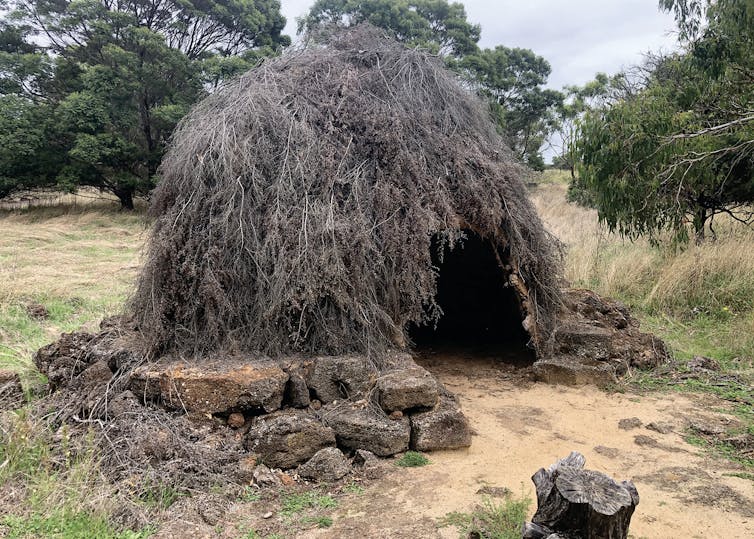
Eminent Australian anthropologist Peter Sutton and respected field archaeologist Keryn Walshe have co-authored a meticulously researched new book, Farmers or Hunter-gatherers? The Dark Emu Debate. It’s set to become the definitive critique of Bruce Pascoe’s Dark Emu: Black Seeds — Agriculture or Accident?
First published in 2014, Pascoe’s Dark Emu has spawned numerous derivatives. Pascoe contends that in pre-contact times, Australian Aboriginal people weren’t “mere” hunter-gatherers, but agriculturalists. Descriptors like “simple” or “mere” are anathema to people like me who’ve lived long-term with hunter-gatherers.
For many Australians, Pascoe’s book is a “must-read”, speaking truth to power. For such readers, Dark Emu seems a breakthrough text. Not so, in Sutton and Walshe’s estimation. Nor mine.
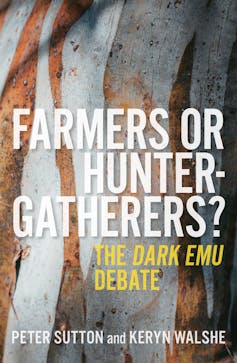
Underpinning Dark Emu is the author’s rhetorical purpose. This proselytising is partly achieved by painstaking “massaging” of his sources, a practice forensically examined by Walshe and Sutton. It has led to converts to Pascoe’s dubious proposition. But this willingness to accept Pascoe’s argument reveals a systemic area of failure in the Australian education system.
On the basis of long-term research and observation, Sutton and Walshe portray classical Australian Aboriginal people as highly successful hunter-gatherers and fishers. They strongly repudiate racist notions of Aboriginal hunter-gatherers as living in a primitive state.
In their book, they assert there was and is nothing “simple” or “primitive” about hunter-gatherer-fishers’ labour practices. This complexity was, and in many cases, still is, underpinned by high levels of spiritual/cultural belief.
Not Agriculturalists
As Sutton attests, seeds were and are occasionally deliberately scattered. But in classical Aboriginal societies they were never planted nor watered for agricultural purposes. Such aforementioned rituals are collectively called “increase ceremonies”. Sutton’s alternative term, “maintenance ceremonies”, invokes spiritual propagation as opposed to oversupply.
Their objective was continuing subsistence. Australia’s hunter-gatherer-fishers left an extremely light carbon footprint — the diametric opposite of many contemporary agricultural/industrial practices. The photo below, taken in 1932 or earlier, shows Pilbara people throwing yelka (nutgrass) — not threshing or scattering seeds.
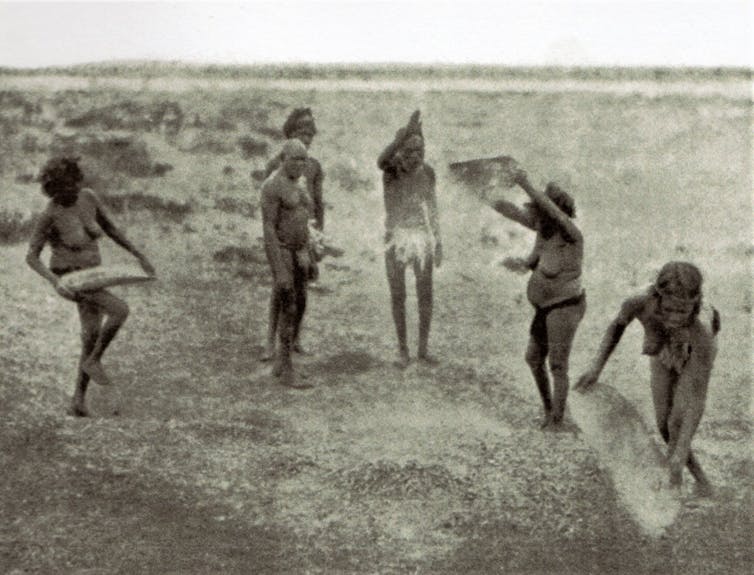
Pascoe’s Sources And Approach
Pascoe draws on records of explorers and early colonists, also citing recent works, including Bill Gammage’s The Biggest Estate on Earth: How Aborigines made Australia. Dark Emu leans most heavily on the work of the late historian/ethnographer Rupert Gerritsen.
Read more: Friday essay: Dark Emu and the blindness of Australian agriculture
Counter-intuitively, Pascoe mainly cites non-Aboriginal sources. There is no real “voice” given to the few remaining people who lived traditional lives as youngsters, or are cited in books or articles.
While some have described Dark Emu as fabrication, Sutton and Walshe are more measured. They methodically show that in Dark Emu, Pascoe has removed significant passages from publications that contradict his major objectives. This boosts his contention that all along Aboriginal people were farmers and/or aquaculturalists.
One example concerns Pascoe’s quoting of the journal entries of the explorer Charles Sturt. Sutton writes:
Sturt is quoted [by Pascoe] on his party’s discovery of a large well and ‘village’ of 19 huts somewhere north of Lake Torrens in South Australia.
This “village” concept arose from colonial records, and is still sometimes used in recent articles.
Pascoe’s edit of Sturt’s original 1849 text breathes oxygen into Dark Emu’s polemical edge. It’s misleading at best. For Sturt’s diary reveals Aboriginal people didn’t live in “houses” in any single site all year round.
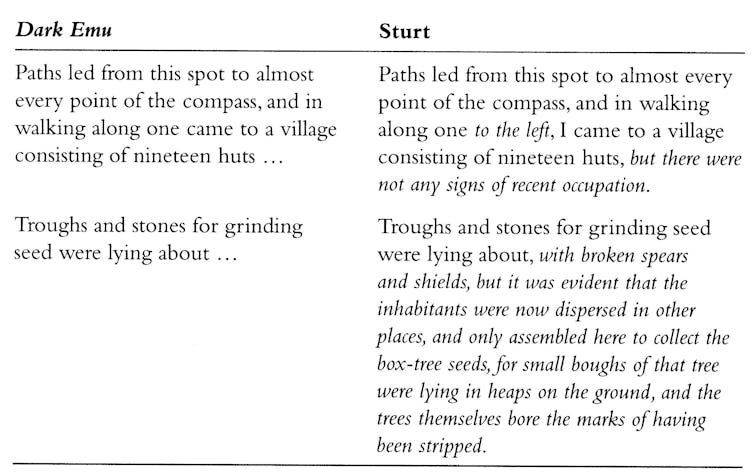
Such accounts destabilise Pascoe’s argument, reinforced by ethnographic, colonial, and archaeological records.
Hunter-gatherers did alter the country in significant ways — most Australians know about the ancient practice of firing the country, recently discussed in depth owing to our increasingly devastating bush-fires. This involved ecological agency and prowess. But expert fire-burning isn’t an agricultural practice, as Pascoe avers.

Misidentification Of Implements
In a key chapter, Walshe homes in on Pascoe’s mis-interpretations of hunter-gatherer implements, which he labels “agricultural” tools. For instance, Pascoe misconstrues grooved “Bogan Picks” as heavy stones used for agricultural activity.
Walshe disputes Pascoe’s claim, stating that, “with their adze-shaped end and grooved midline for hafting, they were likely used in a similar way to stone axes.”
Wooden digging sticks were also used for breaking up the earth to extract yams when in season, among various other purposes — not for “tilling” or “ploughing” the soil in preparation for planting seeds.

Language used by early colonists and explorers — words like “village” and “picks” — befuddles readers. British colonists’ monolingualism meant they used English words, often imposed arbitrarily, to name never-before-seen hunter-gatherer implements. For example, “Bogan Pick” references the nearby Bogan River.
Hunter-Gatherer Mobility And Stasis
Sutton expertly summarises the experience of escaped convict, William Buckley, who spent 32 years travelling around country with the Wathawurrung people in Central Victoria.
Over time, Buckley became fluent in the language of his Wathawurrung hosts. Later, his oral account of the hunter-gatherer group’s approximate lengths of mobility and stasis at numerous sites was transcribed. It’s a unique document covering a significant timespan.
This account reinforces earlier chapters in Dark Emu Debate. Sutton and Walshe make it crystal clear that Aboriginal people weren’t “simple nomads” wandering around randomly, opportunistically searching for food and water. They knew their country intimately.
Rather, hunter-gatherers engaged in purposeful travel to sites with which they familiar and able to source seasonally available food, water and shelter at variable times of year.
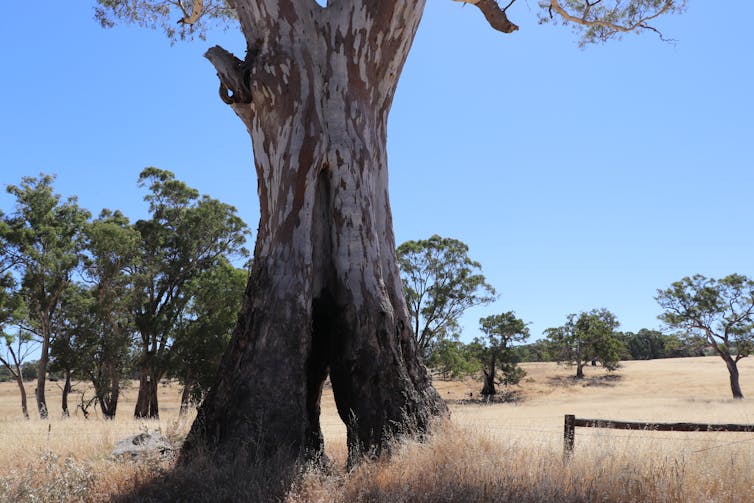
Another conspicuous weakness in Dark Emu’s approach, pinpointed by Sutton and Walshe, is Pascoe’s penchant for choosing exceptions to the general rule, implying that these atypical practices were widespread or universal. It’s another strategy to consolidate his argument but involves eliding vital information.
Pre-Contact Aquaculture
Pascoe offers two examples of “aquacultural” practice, one in Brewarrina (NSW) in the bed streams of the Barwon River, and the other in Lake Condah, in south-western Victoria.
He seizes on rock use in the Brewarrina fishery and Lake Condah’s fish and seasonal eel trapping as “proof” of Aboriginal people’s aqua/agricultural prowess — giving the impression they created these complex hydrological systems from scratch.
But Sutton writes, “The fish traps of Brewarrina … were not claimed as the ingenious works of human beings, but … regarded as having been put there in the Dreaming, by Dreamings.” Both he and Walshe readily acknowledge the fact that Aboriginal people use/d their human agency to create modifications. It’s not an either/or matter.

However, a chapter written by Walshe throws light on the seismic activity that forged Lake Condah’s unique terrain and waterways. This area, she writes, is part of
a volcanic system … last active … 9,000 years ago, with a major eruption much earlier, about 37,000 thousand years ago, causing a massive lava flow across the pre-existing drainage system.
The natural tilt southwards, she explains, facilitated “naturally formed ancient river channels … to reach the Southern Ocean”.
This enabled migratory fish to spawn. Fish, and at certain times of year, eels, swam through both fresh and salty water — making for ease of catching. Local Aboriginal people moved the heavy stones into semi-circular formations to enable netting, spearing or grabbing by hand, possibly creating further semi-captivity of these food staples.
In this way, hunter-gatherers consistently and constantly “value-added” to, or enhanced, nature’s creation.
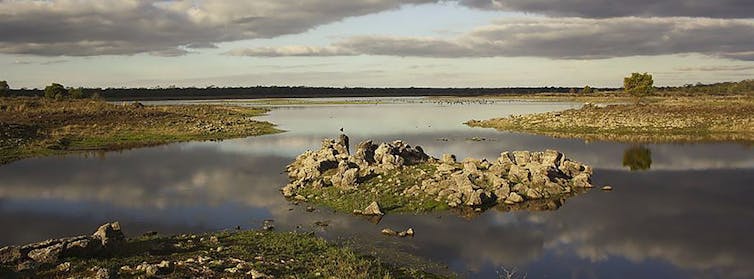
Read more: The detective work behind the Budj Bim eel traps World Heritage bid
Not A Bunfight
Pascoe’s skilful editing of his sources involves conscious, deliberate intervention. Does he hope Dark Emu will convince people to change their belief in the noxious evolutionary ladder, once uniformly, but still sometimes, applied to different groups of homo sapiens?
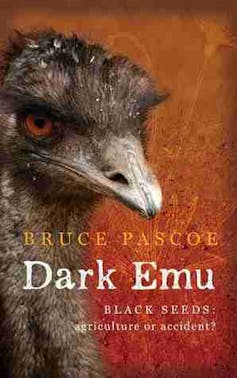
Or was his book written to prove Aboriginal people were/are more like Europeans, which could perhaps lead to much needed progress on reconciliation? Perhaps that accounts for its rapturous reception by many Australians, especially the young.
Why not simply celebrate the long-term achievements of hunter-gatherers?
Hunter-gatherers worked in concert with the natural world, not against it as most humans do today, resulting in insoluble difficulties such as overcrowding, pandemics and toxic agricultural and aquacultural practices. Survival depends on this. For eons, it ensured the continuity and the continuing existence of Australia’s hunter-gatherer people and their culture.
Farmers or Hunter Gatherers? The Dark Emu Debate needs to be read carefully, keeping an open mind. The book’s focus is on both material and spiritual economies and their misrepresentation. Despite racist commentary from some, this isn’t an exclusively right or left-wing issue or a bunfight.
Bruce Pascoe’s Dark Emu will continue to be granted recognition, if not immortality. But Sutton and Walshe’s Dark Emu Debate will undoubtedly be acclaimed. As a critique of Pascoe’s book, it’s just about perfect — a volume with the twin virtues of rigour and readability.
Farmers or Hunter Gatherers? The Dark Emu Debate is published by Melbourne University Press and will be released 16 June 2021.![]()
Christine Judith Nicholls, Honorary Senior Lecturer, Australian National University
This article is republished from The Conversation under a Creative Commons license. Read the original article.
This deep-sea creature is long-armed, bristling with teeth, and the sole survivor of 180 million years of evolution
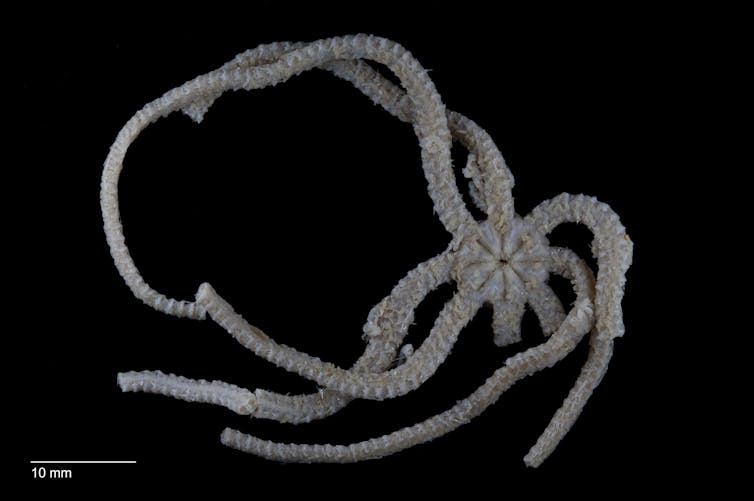
Let me introduce you to Ophiojura, a bizarre deep-sea animal found in 2011 by scientists from the French Natural History Museum, while trawling the summit of a secluded seamount called Banc Durand, 500 metres below the waves and 200 kilometres east of New Caledonia in the southwest Pacific Ocean.
Ophiojura is a type of brittle star, which are distant cousins of starfish, with snake-like arms radiating from their bodies, that live on sea floors around the globe.
Being an expert in deep-sea animals, I knew at a glance that this one was special when I first saw it in 2015. The eight arms, each 10 centimetres long and armed with rows of hooks and spines. And the teeth! A microscopic scan revealed bristling rows of sharp teeth lining every jaw, which I reckon are used to snare and shred its prey.

As my colleagues and I now report in Proceedings of the Royal Society B, Ophiojura does indeed represent a totally unique and previously undescribed type of animal. It is one of a kind — the last known species of an ancient lineage, like the coelacanth or the tuatara.

We compared DNA from a range of different marine species, and concluded that Ophiojura is separated from its nearest living brittle star relatives by about 180 million years of evolution. This means their most recent common ancestor lived during the Triassic or early Jurassic period, when dinosaurs were just getting going.
Since then, Ophiojura‘s ancestors continued to evolve, leading ultimately to the situation today, in which it is the only known survivor from an evolutionary lineage stretching back 180 million years.
Amazingly, we have found small fossil bones that look similar to our new species in Jurassic (180 million-year-old) rocks from northern France, which is further evidence of their ancient origin.
Scientists used to call animals like Ophiojura “living fossils”, but this isn’t quite right. Living organisms don’t stay frozen in time for millions of years without changing at all. The ancestors of Ophiojura would have continued evolving, in admittedly very subtle ways, over the past 180 million years.
Perhaps a more accurate way to describe these evolutionary loners is with the term “paleo-endemics” — representatives of a formerly widespread branch of life that is now restricted to just a few small areas and maybe just a single solitary species.
For seafloor life, the centre of palaeo-endemism is on continental margins and seamounts in tropical waters between 200 metres and 1,000 metres deep. This is where we find the “relicts” of ancient marine life — species that have persisted in a relatively primitive form for millions of years.
Read more: Dancing brittle stars tell an ancient tale of life and death in brutal seas
Seamounts, like the one on which Ophiojura was found, are usually submerged volcanoes that were born millions of years ago. Lava oozes or belches from vents in the seafloor, continually adding layers of basalt rock to the volcano’s summit like layers of icing on a cake. The volcano can eventually rise above the sea surface, forming an island volcano such as those in Hawaii, sometimes with coral reefs circling its shoreline.
But eventually the volcano dies, the rock chills, and the heavy basalt causes the seamount to sink into the relatively soft oceanic crust. Given enough time, the seamount will subside hundreds or even thousands of metres below sea level and gradually become covered again in deep-sea fauna. Its sunlit past is remembered in rock as a layer of fossilised reef animals around the summit.
Voyage Of Discovery
While our new species is from the southwest Pacific, seamounts occur worldwide and we are just beginning to explore those in other oceans. In July and August, I will lead a 45-day voyage of exploration on Australia’s oceanic research vessel, the RV Investigator, to seamounts around Christmas and Cocos (Keeling) Islands in the eastern Indian Ocean.
These seamounts are ancient - up to 100 million years old — and almost totally unexplored. We are truly excited at what we may find.
Seamounts are special places in the deep-sea world. Currents swirl around them, bringing nutrients from the depths or trapping plankton from above, which feeds the growth of spectacular fan corals, sea whips, and glass sponges. These in turn host numerous other deep-sea animals. But these fascinating communities are vulnerable to human activities such as deep-sea trawling and mining for precious minerals.
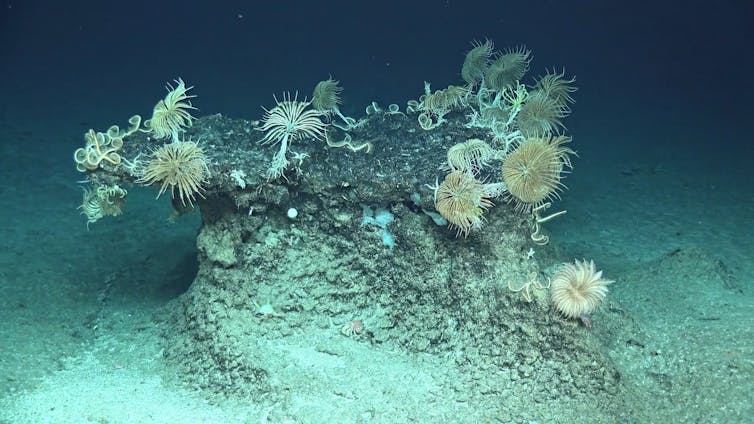
The Australian government recently announced a process to create new marine parks in the Christmas and Cocos (Keeling) regions. Our voyage will provide the data required to manage these parks into the future.
The New Caledonian government has also created a marine park in offshore areas around these islands, including the Durand seamount. These marine parks are beacons of progress in the global drive for better environmental stewardship of our oceans. Who knows what weird and wonderful treasures of the deep are yet to be discovered.
Read more: How we traced the underwater volcanic ancestry of Lord Howe Island ![]()
Tim O'Hara, Senior Curator of Marine Invertebrates, Museums Victoria
This article is republished from The Conversation under a Creative Commons license. Read the original article.
9 in 10 LGBTQ+ students say they hear homophobic language at school, and 1 in 3 hear it almost every day

Bills in the federal and New South Wales parliaments have sought to stop teachers talking about gender and sexuality diversity in the name of either religious freedom or parents’ rights.
If passed in its current form, the NSW Education Legislation Amendment (Parental Rights) Bill 2020 would prohibit teachers from discussing gender and sexuality diversity. It would also make offering targeted, requested support to gender and sexuality diverse (often known as LGBTQ+) students grounds for revoking teachers’ accreditation.
At NSW universities, the bill will mean programs that educate student teachers about the existence of LGBTQ+ students and how best to support them at school would be at risk of losing their accreditation. The same goes for registered professional development of NSW teachers.
Such bills fail to acknowledge the daily realities for many LGBTQ+ youth. These young people experience one of the highest rates of school bullying in the Asia-Pacific and are almost five times more likely to attempt suicide than their peers.
My recent report, Free2Be … Yet? — the second national study of Australian high school students who identify as gender and sexuality diverse — shows alarming rates of homophobic language used in Australian schools. And worse, it shows that, at least from the perspective of students, teachers rarely intervene.
What LGBTQ+ Students Said
The report presents findings from a national survey of 2,376 LGBTQ+ high school students, aged 13–18. The participants went to government, Catholic and independent schools.
The central aim of the research was to investigate the frequency of harassment and violence towards LGBTQ+ students at school. I also wanted to explore associations between elements of the school climate — with respect to gender and sexuality diversity — and the school well-being of these students.
Almost 30% of participants said they had personally experienced or witnessed physical harassment directed at LGBTQ+ students. This group told stories of violence at school, with limited teacher intervention or discussion about the issues.
Of 93% of students who said they had heard homophobic language at school, 37% heard this “almost every day”. Only 6% of students said adults “always” intervened to stop this language.
One year 9 girl who identifies as pansexual wrote:
My classmates call everyone faggots all the time and the teachers just pretend they don’t hear it.
In some cases, students wrote about how the LGBTQ+ student was blamed for the event:
A year 12 boy who identifies as gay said:
[A student] threw a rotten apple at the back of my head after telling me that the common room is for ‘normal straight people only’. The teacher present then told me I had to leave because I was causing trouble by being there.
LGBTQ+ students who went to schools where peers used homophobic and transphobic language more often and with less intervention from adults reported feeling significantly less connected to their school.
They also said they were less confident their teachers could manage bullying and keep them safe. And they were less assured their teachers were personally invested in them and their academic success.
A Diverse-Positive School Climate
A school climate that views gender and sexuality diversity positively is related to LGBTQ+ students’ sense of connection and personal investment in school.
In this survey, LGBTQ+ students scored worse than mainstream peers on nearly every measure of school-based well-being. This included their sense of connectedness to school, a known predictor of academic achievement.

However, where LGBTQ+ students attended schools that explicitly named sexual orientation as a protected category in their harassment policy, those students’ school-based well-being exceeded those of their mainstream peers.
Around three-quarters of students who were in year 9 and above said it was “definitely” or “mostly” false they had learned about a range of gender and sexuality diverse identities in their health and physical education classes.
LGBTQ+ students who reported more inclusion of diversity issues in their curriculum had significantly better school-based well-being than LGBTQ+ students in schools with little to no inclusion.
Unsurprisingly, LGBTQ+ students with higher levels of these forms of well-being were significantly more likely to say they would attend university.
Teacher Attitudes Make A Difference
The study also measured how LGBTQ+ students perceived themselves academically — known as “academic self-concept”. This is measured using eight items that include statements such as: “compared to others my age, I am good at most school subjects” and “it is important to me to do well in most school subjects”.
The survey then asked students to indicate how true it was that their “teachers talk about same-sex attraction (lesbian, gay or bisexual people or topics) in a positive way”. Response options ranged from “definitely false” to “definitely true”.
Looking at students’ mean (average) academic self-concept score against their ratings of teacher positivity, results show that where students viewed their teachers as more positive about same-sex attraction across each of the six response options, they also reported higher academic self-concept.
Likewise, students were asked to indicate how frequently their teachers “do something or say something positive, like stop the student(s) or talk to them about using that language” when “negative language about lesbians, gays or bisexual people is used by students and a teacher or school staff member is present”. Response options ranged from “always” to “never”.
As the graph below shows, students who indicated that their teachers “always” intervened had the highest average academic self-concept, with students who indicated their teachers “never” intervened, reporting the lowest average academic self-concept.
These results show more training and encouragement should be given to Australia’s teachers to speak out against homophobic and transphobic harassment and violence in ways that educate students and reduce its incidence. Such efforts, alongside positive inclusion, can enable LGBTQ+ students to reach their full potential.
If this article has raised issues for you, or if you’re concerned about someone you know, call Lifeline on 13 11 14 or visit Headspace.![]()
Jacqueline Ullman, Associate Professor in Adolescent Development, Behaviour and Wellbeing, Western Sydney University
This article is republished from The Conversation under a Creative Commons license. Read the original article.
Hidden women of history: Eliza Hamilton Dunlop — the Irish Australian poet who shone a light on colonial violence

In this series, we look at under-acknowledged women through the ages.
Eliza Hamilton Dunlop’s poem The Aboriginal Mother was published in The Australian on December 13, 1838, five days before seven men were hanged for their part in the Myall Creek massacre.
About 28 Wirrayaraay people died in the massacre near Inverell in northern New South Wales. Dunlop had arrived in Sydney in February, and the Irish writer was horrified by the violence she read about in the newspapers.
Read more: How can we achieve reconciliation? Myall Creek offers valuable answers
Moved by evidence in court about an Indigenous woman and baby who survived the massacre, Dunlop crafted a poem condemning settlers who professed Christianity but murdered and conspired to cover up their crime. It read, in part:
Now, hush thee—or the pale-faced men
Will hear thy piercing wail,
And what would then thy mother’s tears
Or feeble strength avail!
Oh, could'st thy little bosom
That mother’s torture feel,
Or could'st thou know thy father lies
Struck down by English steel
The poem closed evoking the body of “my slaughter’d boy … To tell—to tell of the gloomy ridge; and the stockmen’s human fire”.
The graphic content depicting settler violence and First Nations’ suffering made Dunlop’s poem locally notorious. She didn’t shrink from the criticism she received in Australia’s colonial press, declaring she hoped the poem would awake the sympathies of the English nation for a people who were “rendered desperate and revengeful by continued acts of outrage”.
An Early Life As A Reader
Dunlop, the youngest of three children, was born Eliza Matilda Hamilton in 1796. Her father, Solomon Hamilton, was an attorney practising in Ireland, England and India. Her mother died soon after Dunlop’s birth, and she was brought up by her paternal grandmother.
Part of a privileged Protestant family with an excellent library, Dunlop grew up reading writers from the French Revolution and social reformers such as Mary Wollstonecraft.
In her teens, Dunlop published poems in local magazines. An unpublished volume of her original poetry, translations and illustrations written between 1808 and 1813 reveals her fascination with Irish mythology and European literature. She was deeply interested in the Irish language and in political campaigns to extend suffrage and education to Catholics.
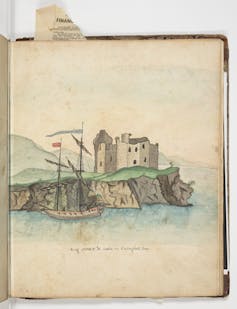
In 1820, she travelled to India to visit her father and two brothers. The journey inspired poems about colonial locations — from the Cape Colony (now South Africa) to the Ganges River — that explored the reach and impact of the British Empire.
In Scotland in 1823, she married book binder and seller David Dunlop. David’s family history inspired poems such as her dual eulogy, The Two Graves (1865), about the bloody suppression of Protestant radicals in the 1798 Rebellion, during which David’s father Captain William Dunlop had been hanged.
The Dunlops had five children in Coleraine, Northern Ireland, where they were engaged in political activity seeking to unseat absentee English landlords, before leaving Ireland in 1837.
Settler Poetry And Politics
When The Aboriginal Mother was published as sheet music in 1842, set to music by the composer Isaac Nathan, he declared “it ought to be on the pianoforte of every lady in the colony”.

Dunlop often wrote about the Irish diaspora in poems which were alternatively nostalgic and political. But she also brought her knowledge of the violence and divisiveness of colonisation, religion and ethnicity to her writing on Australia.
Her optimistic vision for Australian poetry encouraged colonial readers to be attentive to their environment and to recognise Indigenous culture. This reputation for sympathising with Indigenous people — and her husband’s arguments with settlers in Penrith about the treatment of Catholic convicts — were widely criticised in the press.
This affected David’s career as police magistrate and Aboriginal Protector: he was soon moved to a remote location. There, too, local landholders campaigned against his appointment and undermined his authority.
Indigenous Languages
When David was posted to Wollombi in the Upper Hunter Valley, Dunlop sought to expand her knowledge of Indigenous culture, engaging with Darkinyung, Awabakal and Wonnarua people who lived in the area.
She attempted to learn various languages of the region, transcribing word lists, songs and poems, and acknowledging the Indigenous people who shared their knowledge with her.
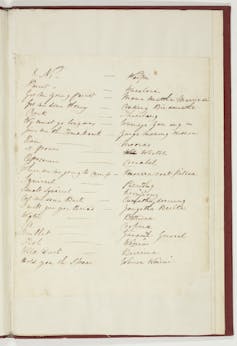
She wrote a suite of Indigenous-themed poems in the 1840s, publishing poems in newspapers such as The Eagle Chief (1843) or Native Poetry/Nung-ngnun (1848). These poems were criticised by anonymous letter writers, questioning her poetic ability, her knowledge and her choice of subject.
Some critics were frankly racist, refusing to accept the human emotions expressed by Dunlop’s Indigenous narrators.
The Sydney Herald had railed against the death sentences of the men responsible for the Myall Creek massacre, and Dunlop condemned the attitude of the paper and its correspondents. She hoped “the time was past, when the public press would lend its countenance to debase the native character, or support an attempt to shade with ridicule”.
Dunlop would publish with one outlet before shifting to another, finding different editors in the volatile colonial press who would support her.
Poetry Of Protest
Dunlop wrote in a sentimental form of poetry popular at the time, addressing exile, history and memory. She published around 60 poems in Australian newspapers and magazines between 1838 and 1873, but appears to have written nothing more on Indigenous themes after 1850. This popular writing also contributed to poetry of political protest, galvanising readers around causes such as transatlantic anti-slavery.
Read more: Five protest poets all demonstrators should read
The plight of Indigenous people under British colonialism inspired many writers, including “crying mother” poems that harnessed the universal appeal of motherhood.
Dunlop’s poems The Aboriginal Mother and The Irish Mother are linked to this literary trend, but her experience of colonialism lent her poetry more authority than writers who sourced information about “exotic” cultures from imperial travel writing and voyage accounts.
In the early 1870s, Dunlop collated a selection of poetry, The Vase, but she was never able to publish. Family demands and financial constraints precluded it.
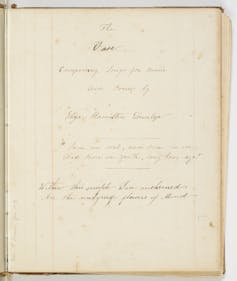
Dunlop died in 1880. Like many women of the time, her writing was neglected and forgotten, until it was rediscovered by the literary critic and editor Elizabeth Webby in the 1960s.
Webby identified Dunlop as the first Australian poet to transcribe and translate Indigenous songs, and as among the earliest to try to increase white readers’ awareness of Indigenous culture. Webby published the first collection of Dunlop’s poems in 1981.
Today, communities and linguists regularly use Dunlop’s transcripts for language reclamation projects in the Upper Hunter Valley.
Last year, 140 years after Dunlop’s death, Wanarruwa Beginner’s Guide — an introduction to one language of the Hunter River area — was published.
At the launch, language consultant Sharon Edgar-Jones (Wonnarua and Gringai) movingly recited one of the songs Dunlop transcribed: revitalising the words of the Indigenous women and men to whom Dunlop listened, when so few white Australians were listening at all.
Eliza Hamilton Dunlop Writing from the Colonial Frontier, edited by Anna Johnston and Elizabeth Webby, is out now through Sydney University Press.![]()
Anna Johnston, Associate Professor of English Literature, The University of Queensland
This article is republished from The Conversation under a Creative Commons license. Read the original article.
How the stunning abstract art of Hilma af Klint opens our eyes to new ways of seeing

Review: Hilma af Klint, The Secret Paintings. Art Gallery of New South Wales.
In 1986, those art historians who see art as some form of linear progression “improving” with time received a rude shock. The Los Angeles County Museum of Art’s exhibition The Spiritual in Art — Abstract Paintings 1890 – 1985 introduced a hitherto unknown woman artist.
The issue was not just that this art was so exquisitely beautiful — but that the paintings had been painted in the early 20th century.
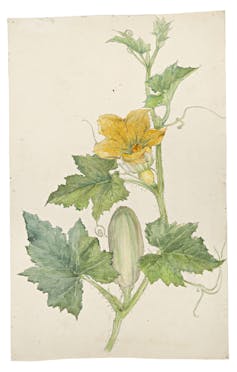
Hilma af Klint was once known as a minor academic Swedish artist. Born in 1862, she had been one of the first women to graduate from the Royal Academy of Fine Arts in Stockholm and had exhibited at the Swedish General Art Association.
But these paintings on display in Los Angeles revealed another life, a different art. Her involvement with spiritualism had radicalised her art to such an extent she can only be described as one of the great abstract artists.
Her work was the sensation of the 2013 Venice Biennale, with a full scale retrospective organised by the Moderna Museet shown in Stockholm, Berlin and Malaga the same year. In 2018, New York’s Guggenheim Museum exhibition broke all attendance records. Hilma af Klint: The Secret Paintings brings her art to the southern hemisphere for the first time.
The transformation of af Klint from competent academic to inspirational mystical abstractionist is a result of the same ideas that influenced many of her contemporaries including Kandinsky, Mondrian, Klee and Malevich.
Rather than rewriting the history of art by slotting her in as a hitherto unknown great woman artist, it is probably more useful to consider these ideas and their impact on her art.
Scientific And Mystical Change
The scientific discoveries of the late 19th and early 20th century encouraged many to question the very nature of the universe.
In the 17th century, Isaac Newton discovered light was made of particles. In the early 19th century, Goethe’s Theory of Colours led many to see colour had spiritual and psychological powers. In the early 20th century, Max Planck demonstrated light particles had energy.
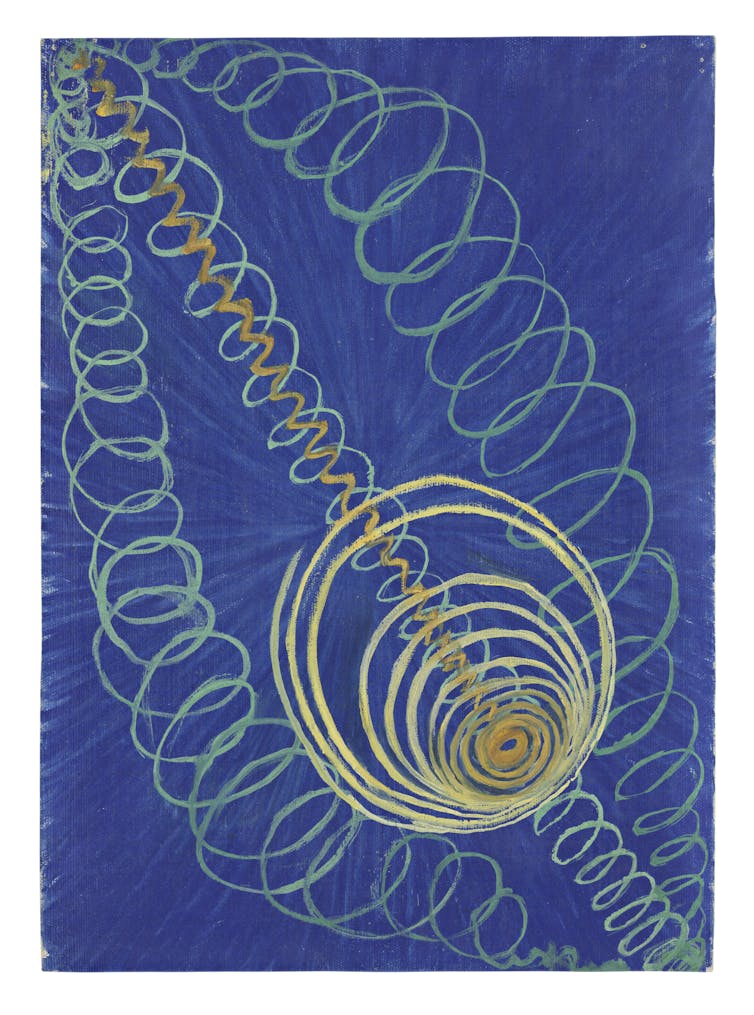
Many began to think that, if the universe was more than it seemed, then perhaps there were other lives living on different astral planes. Perhaps it was possible for some to be mediums, opening themselves to communicate with spirit guides to these worlds.
At the end of the 19th century a new religion, Theosophy, appeared, incorporating both ancient wisdom and modern science.
Today, this may seem esoteric in the extreme, but Theosophy offered an apparently logical and modern system of belief. Its spread was global, and was a major factor behind the liberation of colour in early Australian modernism. In Sydney in 1926, the Theosophical Society was sufficiently mainstream to start a radio station: 2GB.
Read more: Clarice Beckett exhibition is a sensory appreciation of her magical moments in time
It is not surprising af Klint should become a follower. What is surprising is the power of the art unleashed as a consequence.
In 1896, she joined with four colleagues in a group they called The Five whose investigation of the spirit world included automatic drawing.
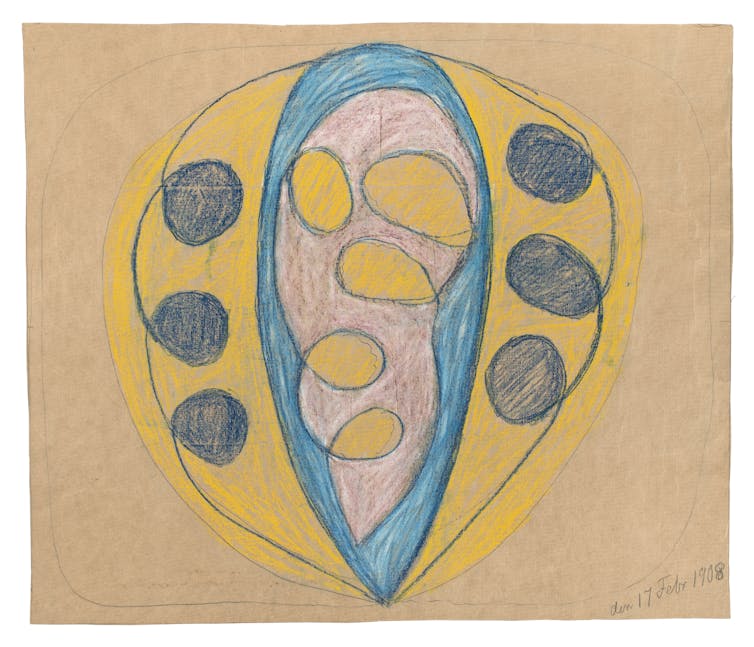
In 1906, her spiritual communications led to her spirit guide Amaliel “commissioning” a new series, The Paintings for the Temple. She later described this as “the one great task that I carried out in my lifetime.”
However, af Klint did not see herself as just a simple conduit for the spirits to control:
it was not the case that I was to blindly obey the spirits, but that I was to imagine that they were always standing by my side.
The first Paintings for the Temple were completed five years before Kandinsky proclaimed his revolutionary argument for abstraction in The Spiritual in Art.
In 1907 she painted her great series of works, The Ten Largest.
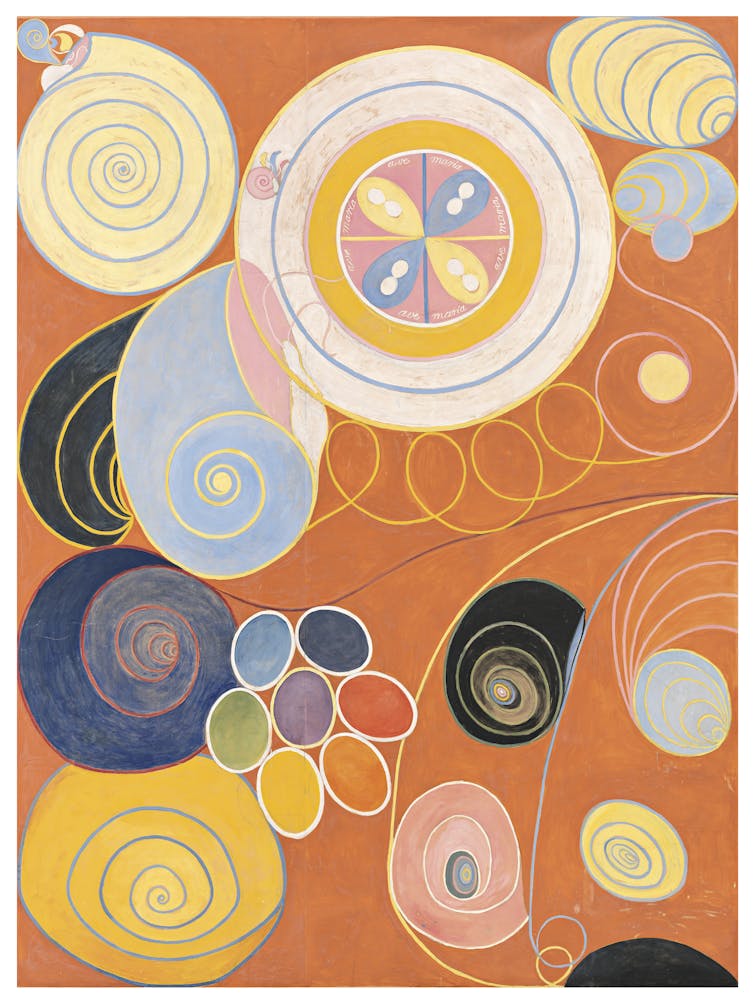
They are, by any measure, a magnificent study of the seasons of life. Elements of nature, geometry and mysterious writing are traced through juvenile floral blues to orange youth, mauves and yellows of adulthood, then in the seeds of old age where the red paint is all scumbled and thin.

The Value In Being Forgotten
To understand both why her art developed the way it did, and why it was so little known for so long, it is probably worth considering the events of her lifetime and her own position.
Hilma af Klint was from an aristocratic Swedish naval family. During the first world war, Sweden’s position was armed neutrality, but she was only too aware of the carnage. Her Swan series, started shortly after the outbreak of war, pitches white swan against black as forms become abstracted, looping in harmony, dissolving into geometry and pure abstraction — until at the very end the two swans are locked together. Each contained elements of the other.

In 1908, Hilma af Klimt showed the Paintings of the Temple to Rudolph Steiner. He failed to understand her work, and did not appreciate the way she saw herself as working with spirits.
This, as well as the burden of caring for her frail and blind mother, may be why she abandoned painting for four years. It may also be why she specified her art be kept secret until 20 years after her death.
There is also a more pragmatic reason. For all its studied neutrality, Sweden was very close to Germany as the Nazis assumed power: radical abstract art with mystical overtones could have caused problems.

Hilma af Klint died in 1944. In 1970, after seeing the riches of his aunt’s creative legacy, her nephew Erik offered her art to Sweden’s Moderna Museet. The gift was rejected out of hand when the director heard she was a mystic and a medium.
A year later Linda Nochlin published Why Have There Been No Great Women Artists? — an essay ushering in a new era of scholarly reassessment of art by women.
Read more: Why weren't there any great women artists? In gratitude to Linda Nochlin
It was perhaps fortunate this gift was rejected. Almost all her art is now owned by the Hilma af Klint Foundation, created by her family. It will never be scattered by the art market nor be the subject of speculation by dealers.
Instead, it is both a constant resource for scholars and for audiences to marvel at the meditative beauty of her forms, the incandescence of her colour and the way she opens eyes to new ways of seeing.
Hilma af Klint: The Secret Paintings is at the Art Gallery of New South Wales until September 19, then City Gallery Wellington from December 4.![]()
Joanna Mendelssohn, Principal Fellow (Hon), Victorian College of the Arts, University of Melbourne. Editor in Chief, Design and Art of Australia Online, The University of Melbourne
This article is republished from The Conversation under a Creative Commons license. Read the original article.
Friendlyjordies producer arrest: what is the NSW Police Fixated Persons Investigations Unit and when is it used?
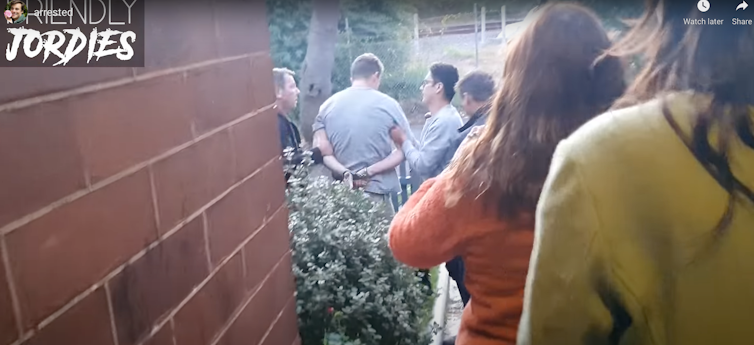
A producer for YouTube comedian Friendlyjordies was recently arrested for allegedly stalking and intimidating NSW Deputy Premier John Barilaro, following investigations by the Fixated Persons Investigations Unit (FPIU) of the NSW police.
This unit, set up in the wake of the Lindt café siege, was created to monitor extremists and fixated persons who may not fall under Australia’s counter-terrorism laws but nonetheless pose a risk of serious violence.
At the heart of this case will be the charges of intimidation and stalking, but it also will raise questions around what constitutes a “fixated person” and when the use of this unit is appropriate.
Read more: Australia doesn't need more anti-terror laws that aren't necessary – or even used
Two Alleged Incidents
Kristo Langker, 21, produces videos for the popular YouTube channel Friendlyjordies, run by Jordan Shanks. At the time of writing, the channel has around 500,000 subscribers.
Shanks has appeared in videos alleging wrongdoing by NSW Nationals leader Barilaro, which Barilaro has strenuously denied. Lawyers for Barilaro say Shanks defamed the deputy premier in a number of “vile and racist” videos. The NSW deputy premier is now suing Shanks (and Google) for defamation.
Langker was arrested at a home in Dulwich Hill, Sydney, on June 4. The charges relate to two alleged incidents.
According to a Guardian Australia news report, the first allegedly occurred at a Macquarie University politics in the pub event. Langker and Shanks (who was dressed as Luigi from Mario Brothers) approached Barilaro and shouted “Why are you suing us?”. According to police, as reported in the Guardian, Shanks then left but Lankger stayed, repeating the question and allegedly “tussling with several persons in an attempt to get close” to Barilaro.
The second alleged incident involved Langker filming and speaking to Barilaro as he returned to his car after the funeral of rugby league player Bob Fulton. According to the same Guardian report, Langker asked the NSW deputy premier again, “why are you suing my boss?”. According to the report, this second incident allegedly occurred hours before Langker’s arrest.
Based on these alleged incidents, Langker was arrested by the FPIU and charged with two counts of stalking and intimidation. The offence attracts a maximum penalty of five years imprisonment, where someone stalks or intimidates another person with intent to cause the person fear of physical or mental harm.
Langker has been released on bail under very strict conditions. He is even prohibited from possessing images or caricatures of the deputy premier, or “commenting on his appearance or behaviour”.
The Fixated Persons Investigations Unit
The FPIU was established in April 2017, shortly before the NSW coroner released his report into the Lindt café siege.
In announcing the new unit, NSW Police Commissioner Mick Fuller referred to people who are “obsessed about issues, ideals or individuals” and are “plotting acts of violence” or “capable of acts of terrorism”.
The unit comprises 17 detectives and government mental health workers. It is based on similar units established previously in the UK and Queensland.
The FPIU is a specialist unit that performs risk assessments of people with obsessions, grievances or ideologies that may lead to serious violence. It can access a suspect’s medical records to assess the level of risk they pose.
People monitored by the FPIU include a man who bombed a couple’s car following months of online abuse, and another who was charged with terrorism offences after threatening Sydney police with a knife.
The NSW coroner supported the unit’s creation, calling it a “commendable” step towards improving terrorism prevention. He believed there was a clear gap in the identification and management of “lone-actor terrorists or fixated individuals”, who could fall through the cracks despite repeated warning signs of violence.
In response to questions from The Conversation, NSW Police said the FPIU investigates “fixated persons”, which is defined as someone who
has an obsessive preoccupation, pursued to an excessive or irrational degree with:
a public office holder or internationally protected person, or
other person/s nominated by the commissioner of police, or
a cause influenced by an extreme ideology (a “cause” is an intensely personal and idiosyncratic grievance or quest for justice).
Police might argue Langker fits under the first of these grounds, if the content and conduct towards Barilaro could be classed as obsessive and excessive. Langker’s lawyers have argued Langker’s arrest and bail conditions “strike at the core of our democracy”.
At trial, the issue will be whether the charges of stalking and intimidation can be proven beyond a reasonable doubt, but the case may also set a precedent about what is fixated behaviour and an appropriate use of the FPIU. If that bar is set too low, there will be a serious risk to free speech and democracy. Of course, everything will turn on the evidence at trial, so we should watch this case closely.![]()
Keiran Hardy, Postdoctoral Research Fellow, Griffith Criminology Institute, Griffith University
This article is republished from The Conversation under a Creative Commons license. Read the original article.
Why is everyone so obsessed with going to Mars? Here are some other worlds ripe for exploration

Last month, China successfully landed and deployed the Zhurong rover on Mars, becoming the second country ever to set wheels on the surface of the red planet.
Last year the United States, the United Arab Emirates and China all launched missions to Mars, taking advantage of the relatively short journey time offered by the two planets’ unusually close proximity.
Why are planetary scientists so obsessed with Mars? Why spend so much time and money on this one planet when there are at least seven others in our solar system, more than 200 moons, countless asteroids, and much more besides?
Fortunately, we are going to other worlds, and there are lots of missions to very exciting places in our solar system — worlds bursting with exotic features such as ice volcanoes, rings of icy debris, and huge magnetic fields.
There are currently 26 active spacecraft dotted around our solar system. Some are orbiting other planets and moons, some have landed on the surfaces of other worlds, and some have performed fly-bys to beam back images. Only half of them are visiting Mars.
Included in those 26 spacecraft are long-term missions like Voyager 1 and 2 - which are still operational after over 40 years and have now left the Solar system and ventured into interstellar space. And it also includes some less famous, but no less weird and wonderful, spacecraft.

Take the Juno spacecraft in orbit around Jupiter, for example. Launched in 2011, it arrived in orbit around Jupiter almost five years later. It is now measuring various properties of the giant planet, including its magnetic field, atmospheric conditions, and determining how much water is in Jupiter’s atmosphere. This will help theorists work out which planet formation theory is correct (or if new theories are needed). Juno has already surpassed its planned seven-year mission duration, and has been extended to at least 2025.
Rocky Ride
One of the most complex feats of astrodynamics was completed late last year when the Japanese Space Agency (JAXA) not only landed a spacecraft on an asteroid, but in a spectacular slingshot manoeuvre, returned a sample to Earth.
Hayabusa2, named after the Japanese term for a peregrine falcon, completed a rendezvous with asteroid 162173 Ryugu in 2018, surveying the surface and taking samples.
Departing in 2019, Hayabusa2 used its ion engines to change orbit and return to Earth. On December 5, 2020, a sample-return capsule about the size of a hatbox and weighing 16 kilograms was dropped through Earth’s atmosphere, landing unscathed at the Woomera Test Range in Australia.
As JAXA begins analysing the rocks and dust collected on the Ryugu asteroid, Hayabusa2 is off on its travels once more - this time to meet up with a second asteroid, 1998 KY_(26), some time in 2031.
Well Of Knowledge
Not included in the list of planetary missions earlier, are those spacecraft trapped in “gravitational wells” within our Solar system.
There are special locations in orbits called “Lagrangian points”, which are gravitationally balanced spots between two bodies.
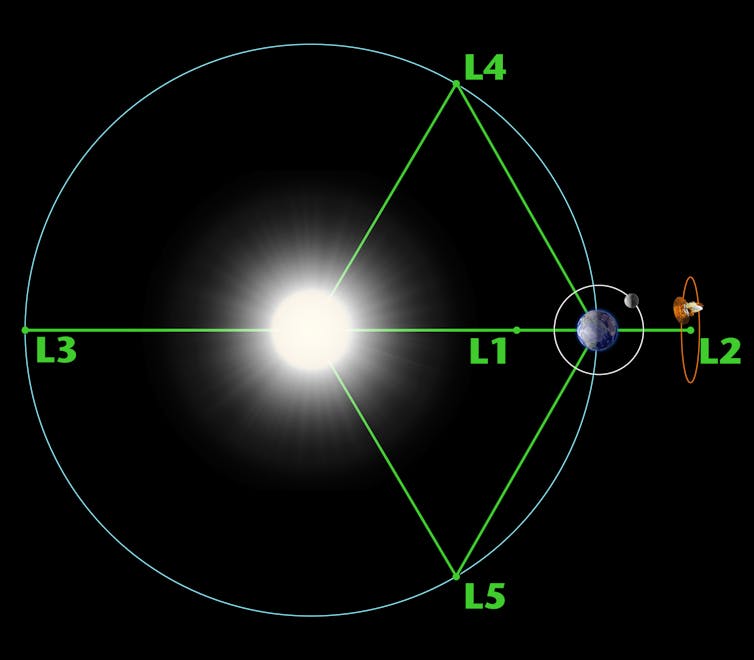
The Solar and Heliospheric Observatory (SOHO) is one of four spacecraft close to the Lagrangian point between the Earth and the Sun, roughly 1.5 million kilometres from Earth (about four times further away than the Moon).
It makes observations of the Sun’s outer layer and the solar wind, sending early warning back to Earth of potentially disastrous space weather. Geomagnetic storms from the Sun are powerful enough to hit the Earth with electromagnetic blasts so strong they have been known to take out country-wide power grids.

Another hostile location is our nearest planetary neighbour, Venus. Despite the searing temperatures and crushing pressures on the surface, NASA recently approved funding for two big missions to explore the origins of Venus and its atmosphere. The discovery of phosphine gas in the upper atmosphere led life scientists to believe life may exist at the more habitable and cooler temperatures of higher altitudes.
Hot on the heels of the successful flight of the Ingenuity helicopter on Mars — the first flight of any powered aircraft on another world — NASA’s Dragonfly mission will fly a drone through the atmosphere of Saturn’s icy moon, Titan. Launching in 2026 and arriving in 2034, the rotorcraft will fly to dozens of promising locations on Titan looking for any chemical precursors or life similar to those on Earth.
So How Much Does All This Cost?
Governments tend to allocate relatively small amounts of their budgets to science and space exploration. Countries typically spend less than 1% of their budget on space missions — far less than social services or military defence.
Deciding what space missions will receive that money is very often driven by public interest. But trying to decide definitively which probe or spacecraft offers the most bang for buck is almost impossible.
When humans first set foot on the Moon, 25% of the world’s population watched the video with bated breath, inspiring several generations of space explorers for decades afterwards. You can’t put a price on that.![]()
Gail Iles, Senior Lecturer in Physics, RMIT University
This article is republished from The Conversation under a Creative Commons license. Read the original article.
Prehistoric ‘river boss’ is the largest extinct croc species ever discovered in Australia
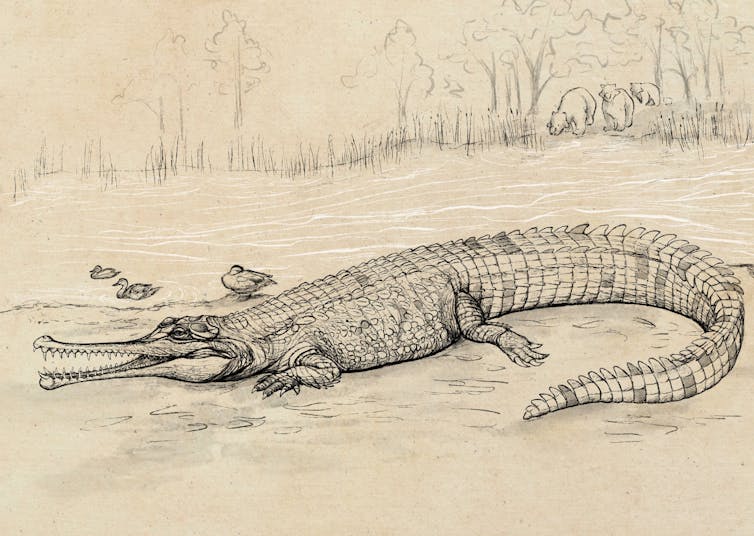
Say hello to Gunggamarandu maunala, or the “hole-headed river boss” — the biggest extinct croc yet found in Australia, and an important addition to the jigsaw of crocodylian evolution.
The newly named species, known from a partial skull that was unearthed in Queensland’s Darling Downs region, belongs to a group called the tomistomines. Before this, tomistomines had never been found in Australia.
Today, there are only two crocodile species living in Australia: the Australian freshwater crocodile and the Indo-Pacific crocodile (also known as the estuarine or saltwater crocodile). The latter is the largest living reptile in the world, capable of reaching more than six metres in length and weighing more than a tonne.

As impressive as these two species are, there were many more types of crocs in Australia’s prehistoric past. Currently, there are 21 named species of extinct Australian crocodylians spanning the past 66 million years, an era known as the Cenozoic. Of these, 19 belong to a group called the Mekosuchinae, which was found only in Australia and the southwest Pacific.
Mekosuchines came in many shapes and sizes, ranging from less than two metres long to well over five metres, and with diverse snout shapes that indicate different lifestyles and methods of acquiring prey. Some were semi-aquatic ambush predators similar to today’s crocodiles and alligators, whereas others likely hunted on land. The last mekosuchines persisted on a few Pacific islands until they went extinct not long after human colonisation.
Endemic Crocodylian Overlords?
Crocodylian palaeontology in Australia has been particularly active over the past 30 years, especially during the 1990s when many significant discoveries were made. Since then, almost all studies have indicated that the vast majority of extinct crocodylians from Australia were mekosuchines. This has led to the perception that mekosuchines were the dominant, if not only, crocodylians in Australia, until the relatively recent arrival of true crocodiles (that is, members of the genus Crocodylus) such as the two species that survive today.
A continent represented by just a single group of crocodylians for more than 60 million years is rather unusual. With the exception of Antarctica, all other continents had representatives of more than one crocodylian group at some point of the Cenozoic. Crocodiles, gharials and alligators still live in Asia today, and the Americas are home to crocodiles, caimans and another species of alligator. Why should Australia be any different?
Read more: Crocodiles today look the same as they did 200 million years ago – our study explains why
As it turns out, our new discovery reveals crocs were not as lonely on this continent as we once thought, because Gunggamarandu maunala is Australia’s first recorded tomistomine crocodylian.
The name Gunggamarandu maunala is based on words from the languages spoken by the Barunggam and Waka Waka nations in the Darling Downs region. Gunggamarandu translates as “river boss”, and maunala means “hole head”, in reference to the large openings on the top of its skull that served as sites for attachment of large jaw muscles.
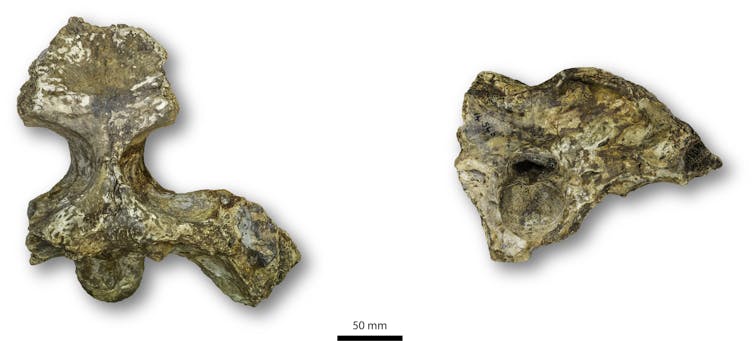
Tomistomines are yet another group of crocodylians with a long fossil record, spanning more than 50 million years. Except for Antarctica, Australia was the only other continent where fossil remains of tomistomines had never been found. With the discovery of Gunggamarandu, Australia is now officially a member of the “once inhabited by tomistomines” club.
Today, there is only one living species of tomistomine in the world, the so-called false gharial, which lives in fresh water on the Malay peninsula and some Indonesian islands. One of the most obvious characteristics of this species, and its extinct relatives, are their long, slender snouts.
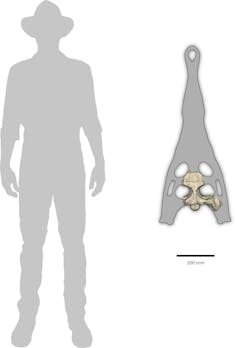
An Australian Croc… From Europe?
The discovery of a new crocodylian species is exciting in its own right, but the significance of our study doesn’t end there. As the first known tomistomine from Australia, Gunggamarandu proves that crocodylians on this continent were more diverse than we realised.
The region where Gunggamarandu was discovered – the Darling Downs – is the southernmost locality for any tomistomine in the world.
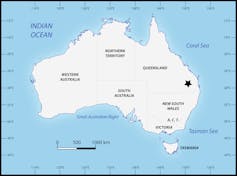
It’s not possible to tell exactly how big Gunggamarandu maunala was, because all we have so far is a partial skull. But the proportions of the fossil suggest it is the largest known extinct croc from Australia.
What’s more, CT scans of the skull allowed us to digitally reconstruct the brain cavity of the animal, resulting in the most detailed look of these anatomical features for an extinct tomistomine yet.

All of these are exciting discoveries. But arguably our most surprising finding regards the ancestry of Gunggamarandu. It is most similar to tomistomines that lived in Europe more than 50 million years ago, despite the fact Gunggamarandu maunala is between five million and two million years old.
This implies a “ghost lineage”, stretching some 50 million years into the past, linking the European and Australian tomistomines. It also suggests that more tomistomines, closely related to Gunggamarandu, may await discovery in Asia.
Exactly when tomistomines arrived in Australia is unclear, but the marine barrier between Southeast Asia and Australia would have been sufficiently small to cross for a crocodylian from at least 25 million years ago.
Jorgo Ristevski, PhD candidate, The University of Queensland and Steven W. Salisbury, PhD; Senior Lecturer, School of Biological Sciences, The University of Queensland
This article is republished from The Conversation under a Creative Commons license. Read the original article.
New Research Finds 1 Million Early Deaths In 2017 Attributable To Fossil Fuel Combustion
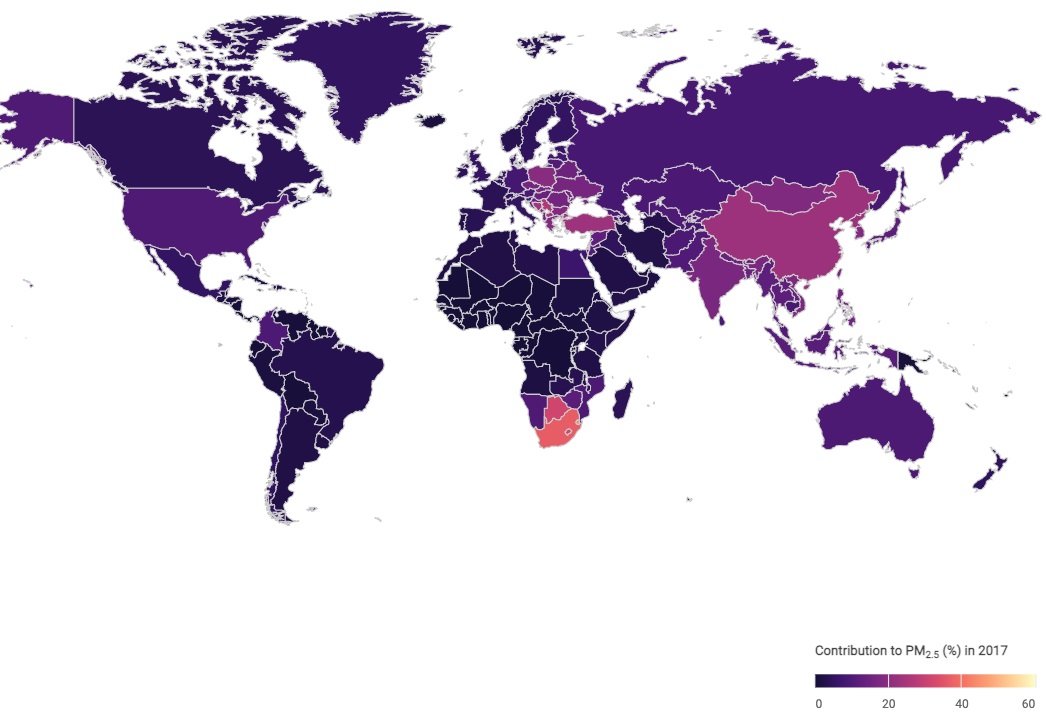
Studying Wombat Burrows With WomBot: A Remote-Controlled Robot
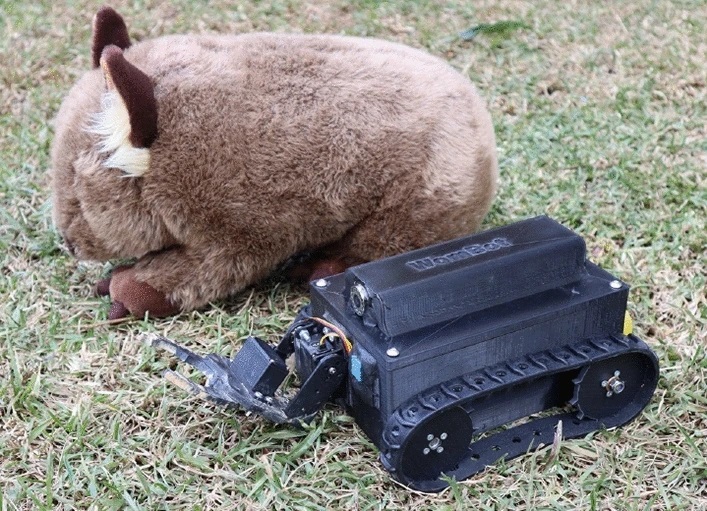 A new robot -- named WomBot -- that can be used to explore and study wombat burrows is presented in a study published in the journal SN Applied Sciences. Wombats reside and sleep in burrows and occupy a different burrow every four to ten days. Parasitic mites that cause sarcoptic mange, a serious disease affecting wombats, are thought to be transmitted when wombats occupy each other's burrows but it has not been clear whether conditions within burrows promote this transmission.
A new robot -- named WomBot -- that can be used to explore and study wombat burrows is presented in a study published in the journal SN Applied Sciences. Wombats reside and sleep in burrows and occupy a different burrow every four to ten days. Parasitic mites that cause sarcoptic mange, a serious disease affecting wombats, are thought to be transmitted when wombats occupy each other's burrows but it has not been clear whether conditions within burrows promote this transmission.Teenagers At Greatest Risk Of Self-Harming Could Be Identified Almost A Decade Earlier
Untapped Rice Varieties Could Sustain Crop Supplies In Face Of Climate Change
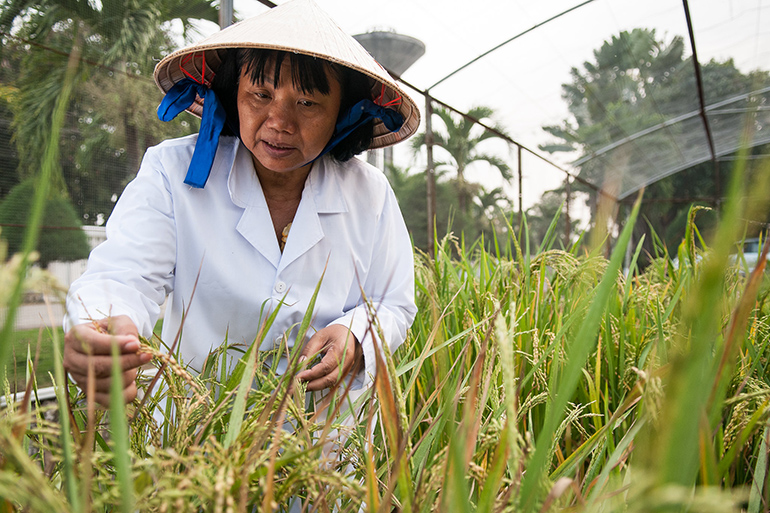 Local rice varieties in Vietnam could be used to help breed improved crops with higher resilience to climate change, according to a new study published in Rice. Earlham Institute researchers are part of an international collaboration with genebanks and rice breeders in Vietnam -- championed by the International Rice Research Institute (IRRI) to help abolish world poverty and hunger -- are aiming to identify varieties that can survive an increasingly unpredictable climate.
Local rice varieties in Vietnam could be used to help breed improved crops with higher resilience to climate change, according to a new study published in Rice. Earlham Institute researchers are part of an international collaboration with genebanks and rice breeders in Vietnam -- championed by the International Rice Research Institute (IRRI) to help abolish world poverty and hunger -- are aiming to identify varieties that can survive an increasingly unpredictable climate.Rudeness Leads To Anchoring; Including In Medical Diagnoses
Soaking Up The Sun: Artificial Photosynthesis Promises Clean, Sustainable Source Of Energy
Fashion For Pointy Shoes Unleashed Plague Of Bunions In Medieval Britain
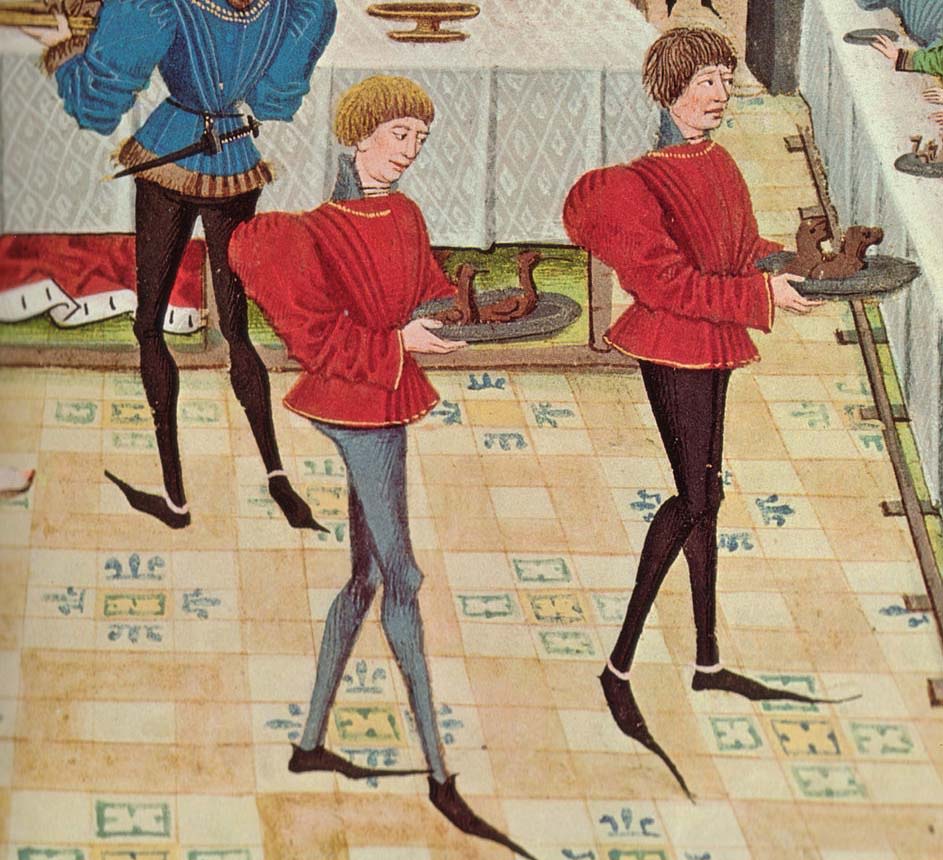
Huge Prehistoric Croc 'River Boss' Prowled Queensland Waterways
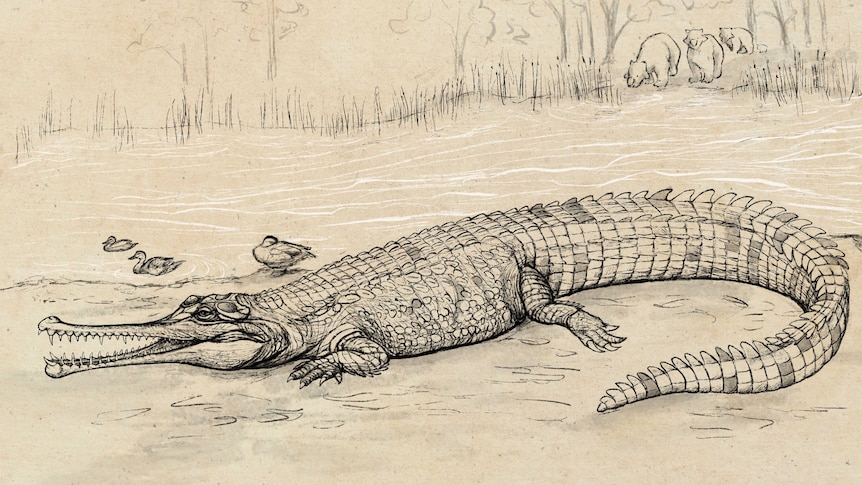
No, it’s not just a lack of control that makes Australians overweight. Here’s what’s driving our unhealthy food habits
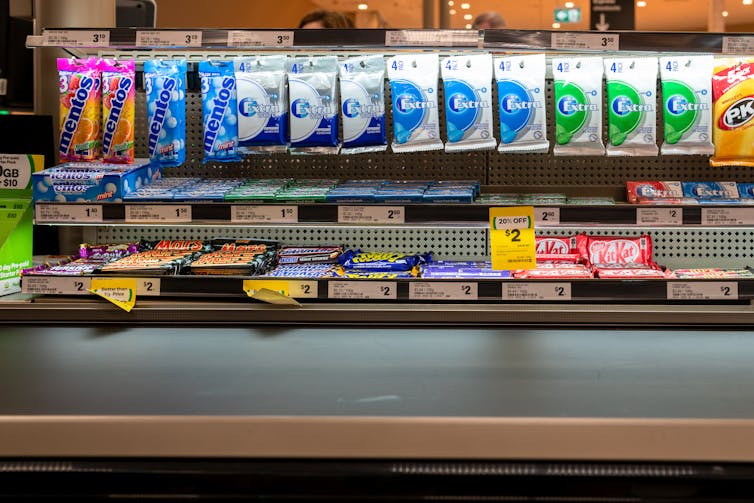
Public health experts have long argued that when it comes to preventing obesity, we need to stop blaming individuals.
Our new online tool, released today, confirms we live in an environment where the odds of having a healthy diet are heavily stacked against us.
Unhealthy foods are readily available and heavily marketed to us by the food industry. This makes it very easy to over-consume unhealthy foods. It also makes it very difficult to consistently select healthy options.
Our online tool – Australia’s Food Environment Dashboard – brings together the best-available data to describe Australia’s food environments. For the first time, we have a clear picture of the ways our environment drives us to consume too much of the wrong types of foods.
Supermarkets Heavily Promote Unhealthy Food
Australian supermarkets are a key setting in which unhealthy foods are pushed at us.
More than half of the packaged food on Australian supermarket shelves is unhealthy. At end-of-aisle displays, unhealthy products are promoted much more often than healthier products.
Read more: Supermarket price deals: the good, the bad and the ugly
Unhealthy products are also “on special” almost twice as often as healthy foods. What’s more, the discounts on unhealthy foods are much larger than the discounts on healthier foods.
And at checkouts, it’s almost impossible to pay for groceries without being exposed to unhealthy foods.
All of this intense marketing for unhealthy foods contributes to the unhealthy mix of products in our supermarket trolleys.
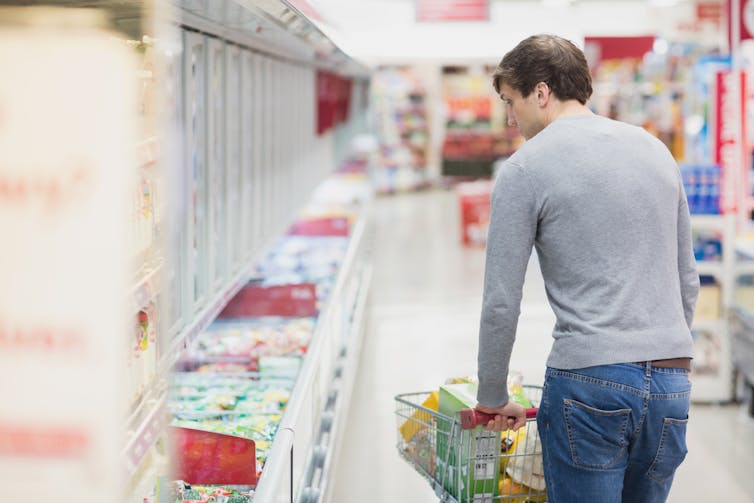
Children’s Exposure To Junk Food Promotion
Australian children cannot escape unhealthy food marketing. As they travel to school, and play and watch sport in their community, kids are exposed to a constant barrage of promotions for unhealthy food and drinks.
When they turn on the TV they will see more than twice as many ads for unhealthy food compared to healthy food.
And when kids are on their mobile devices, they are hit with as many as ten unhealthy food and drink ads every hour.
It’s Worse In More Disadvantaged Areas
Our dashboard shows food environments in disadvantaged areas are less healthy than those in advantaged areas. The cost of a healthy diet is generally higher in low socioeconomic areas and is much higher in very remote parts of Australia.
Critically, the cost of a healthy diet is simply unaffordable (meaning it costs more than 30% of a household’s income) for people on low incomes and those living in rural or remote areas.
Read more: Supermarkets claim to have our health at heart. But their marketing tactics push junk foods
People living in low socioeconomic areas are also exposed to more promotions for unhealthy food. A study in Perth, for example, found low socioeconomic areas had a significantly higher ratio of unhealthy food ads to healthy ads within 500m of schools, compared to high socioeconomic areas.
Some Good News Stories
While almost all the key aspects of food environments in Australia are currently unhealthy, there are some areas that support health.
Our major supermarkets are leading the way in displaying the Health Star Rating on their home-brand product labels, which helps consumers make more informed food choices.
Read more: We looked at the health star rating of 20,000 foods and this is what we found
Some state governments have shown great progress in creating healthier environments in their hospitals and other health services, by offering water and nuts in vending machines, for example, rather than sugary drinks and lollies.
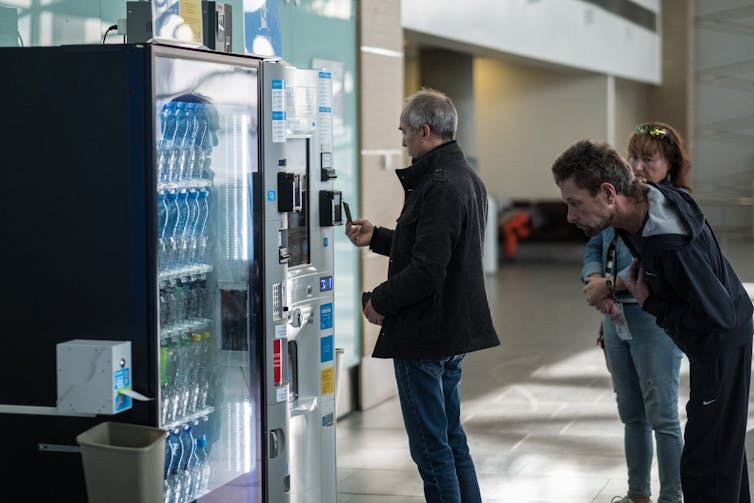
Greater Monitoring Is Needed
Unhealthy diets and obesity are leading contributors to poor health in Australia. For that reason, it’s critical to closely monitor the key drivers of our unhealthy diets.
We’re pretty good at monitoring our exposure to other key health risks and taking public health action accordingly. For example, the government has successfully reduced road fatalities through a range of measures, including prominent identification and eradication of traffic “black spots”.
Now we need the same level of attention paid to our food environments, where there are still some key gaps in our knowledge.
For example, while most state governments have policies to guide foods available in schools, only Western Australia and New South Wales monitors and/or reports adherence to policies.
In many other areas, such as food promotion, data is not routinely collected. This means we often need to rely on data that’s a few years old and that might only be relevant to small geographic regions.

Governments Need To Take Stronger Action
The unhealthy state of our food environments indicates much stronger policy action is needed from all levels of government in Australia.
The National Obesity Strategy which is currently in development and now overdue, can provide the framework for Australian governments to fix up the “black spots” in our food environment.
Improvements can be made by introducing globally recommended policies, such as taxes on sugary drinks and higher standards for how the food industry markets its unhealthy food and drink products.
These actions can help ensure all Australians have access to food environments that support healthy diets.
Read more: How much longer do we need to wait for Australia to implement a sugary drinks tax? ![]()
Gary Sacks, Associate Professor, Deakin University and Sally Schultz, PhD Student, Deakin University
This article is republished from The Conversation under a Creative Commons license. Read the original article.
Many of us want to take our dogs on public transport, but others shudder at the thought — what’s the solution?

We’ve been looking at the ways people travel with dogs and what it says about attempts to shift towards a more sustainable and healthier transport system. Our research first established that trips with dogs in Australia are both common and car-dependent. This is because Australia has some of the highest rates of dog ownership in the world but we are relatively unusual compared to other countries in that we restrict people taking dogs on public transport.
We are interested in how this situation might be changed. Our recent research explores why some people might not want dogs on public transport, and how these concerns can be managed.
This research, published in the International Journal of Sustainable Transportation, reports the results of an analysis of 163 comments made on a Conversation article about dogs on public transport. About 40% of comments supported the idea. A similar proportion expressed disapproval.
Read more: Riding in cars with dogs: millions of trips a week tell us transport policy needs to change
The Trouble With Dogs
Many of the negative comments included simple statements about the smell of dogs. Others referenced more complex concerns such as hygiene and disease.
Several focused on the impact on people with allergies to dogs. These comments often pointed out that the rights of people with allergies and of those who do not like dogs should take precedence over the rights of dogs and dog owners.
Some comments referred specifically to concerns about the operation of the transport system. They raised issues such as the increased cleaning workload for facilities, the need to replace upholstery more regularly, as well as concern about who would pay the costs of accommodating dogs on public transport.
There were several passionate comments about dog attacks. Statements that dogs are dirty and dangerous often either implicitly or explicitly referenced the notion that dog owners cannot be trusted to control, or minimise the impact of, their dog.
Many claimed that canine and transport contexts are different in Australia, suggesting a policy that works in, for example, a European country would not work in Australia. Sentiment that Australia is somehow “behind” countries in Europe often underpinned these comments.
Read more: Australians love their pets, so why don't more public places welcome them?
We Need To Listen To Objections, But There Are Solutions
Many of the comments contained opinions that were obviously posted with some emotion. Dogs are, indeed, a polarising issue. This polarity reflects the common perception that there are “dog people”. Policy change proposals must consider the opinions of those who support pets on public transport and those who don’t.
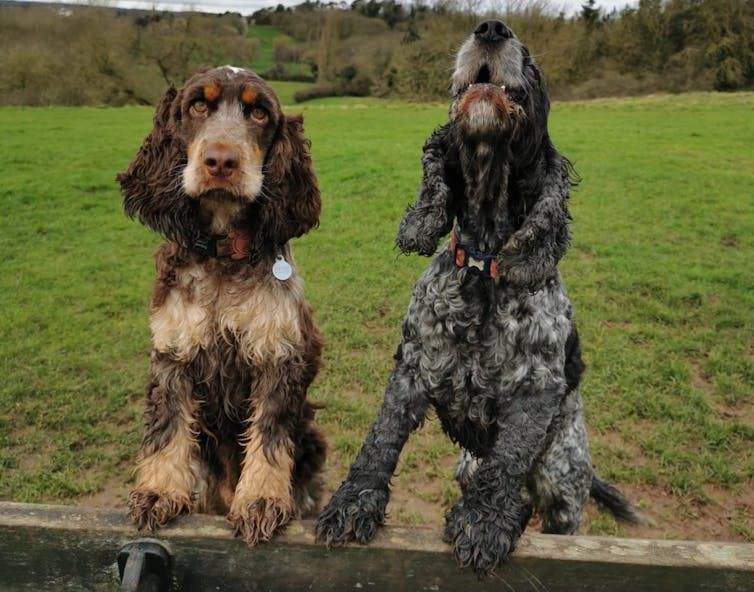
Our analysis, however, does provide several reasons Sydney’s public transport agencies should consider a policy to allow dogs to travel on public transport.
First, negative comments were more likely to demonstrate unfamiliarity with the operational details of a policy that permits dogs to travel on public transport. For example, physical separation of those travelling with dogs could overcome many of the concerns about smell and even allergies. This separation is easily attainable on trains and also possible on buses.
Similarly, concerns about payment could be resolved by ensuring a ticket must be bought for dogs prior to travel, with the fare based on the cost to the system. This may also go part way to alleviating the sense that allowing dogs on transport is a clash of rights between dog owners and non-owners.
Third, negative comments suggesting Australia’s dogs and dog owners are somehow less responsible than their European counterparts are not supported by empirical evidence. Positive local experiences of travelling with well-behaved dogs could soften negative perceptions.
Read more: We need a better understanding of how we manage dogs to help them become better urban citizens
What Might A Policy Change Look Like?
The analysis does suggest opposition could be allayed in time. However, the policy would have to be applied with care.
Other cities that have managed this shift could be consulted for strategies to ensure the policy works well in practice. In Milan, Italy, for example, dogs are allowed only on the first and last carriages of the metro. No more than two dogs are allowed on a bus at any one time.

In Gothenberg, Sweden, only one dog is allowed per bus and the dog must board at the rear of the bus. On trains, dogs are permitted to travel in the last carriage only. In Dublin, Ireland, dogs over a certain size must travel near the guard’s bay on trains.
Read more: Curious Kids: is it true dogs don't like to travel?
It’s Not Just About The Dogs
Travel with dogs might not seem like a priority issue for public transport systems. We argue, though, that Australia’s heavily car-dependent cities need public transport that meets our need for the less obvious, “messy” trips that make up modern lives in cities. By looking beyond the car for these trips, we can develop a system that Australians can use for more than just the journey to work.
This analysis, however, demonstrates the complexity of dragging our public transport systems up to the task of competing with the private car.![]()
Jennifer Kent, Senior Research Fellow in Urbanism, University of Sydney and Corinne Mulley, Professor Emerita, University of Sydney, University of Sydney
This article is republished from The Conversation under a Creative Commons license. Read the original article.
Disclaimer: These articles are not intended to provide medical advice, diagnosis or treatment. Views expressed here do not necessarily reflect those of Pittwater Online News or its staff.